Sharp HRO00058 Cellular Transceiver User Manual e gx33
Sharp Corporation Cellular Transceiver e gx33
Sharp >
Contents
- 1. User Manual
- 2. BT Logo
User Manual

Declaration of Conformity
Hereby, Sharp Telecommunications of Europe Limited,
declares that this GX33 is in compliance with the essential
requirements and other relevant provisions of Directive
1999/5/EC.
A copy of the original declaration of conformity can be
found at the following Internet address:
http://www.sharp-mobile.com
Sharp Telecommunications of Europe Ltd.
Azure House, Bagshot Road, Bracknell, Berkshire RG12 7QY UK
http://www.sharp-mobile.com

Introduction 1
Introduction
Congratulations and thank you for choosing the GX33.
About This User Guide
This User Guide is carefully designed to help you learn about
your phone’s features and operations quickly and effectively.
NOTICE
•
We strongly recommend that you keep separate
permanent written records of all important data. Data
may be lost or altered in virtually any electronic memory
product under certain circumstances. Therefore, we
assume no responsibility for data lost or otherwise
rendered unusable, whether as a result of improper use,
repairs, defects, battery replacement, use after the
specified battery life has expired or any other cause.
• We assume no responsibility, directly or indirectly,
for financial losses or claims from third parties
resulting from the use of this product and any of its
functions, such as stolen credit card numbers, the loss
or alteration of stored data, etc.
• All company and/or product names are trademarks
and/or registered trademarks of their respective
holders.
• Screen layout illustrated in this User Guide may
differ from the actual one.
The information described in this User Guide is
subject to change without notice.
• All the functions described in this User Guide may
not be supported in all networks.
• We assume no responsibility for downloaded
contents, information, etc. from network.
• Occasionally, a few black or bright pixels may appear
on the screen. Please note that this will not have any
impact on any of the features or performance.
Intellectual Property Rights
According to copyright laws, the reproduction,
alteration and use of material which is protected by
copyright (music, pictures, etc.) is only permitted for
personal or private use. If the user is not in possession
of more extensive copyright or has not received the
explicit permission from the copyright owner to
reproduce, alter or use a copy which has been made or
modified in this way, this is considered to be a violation
of the copyright laws and gives the copyright owner the
right to claim for damages. For this reason, avoid the
illegal use of material which is protected by copyright.
Windows is a registered trademark of Microsoft
Corporation in the United States and/or other countries.
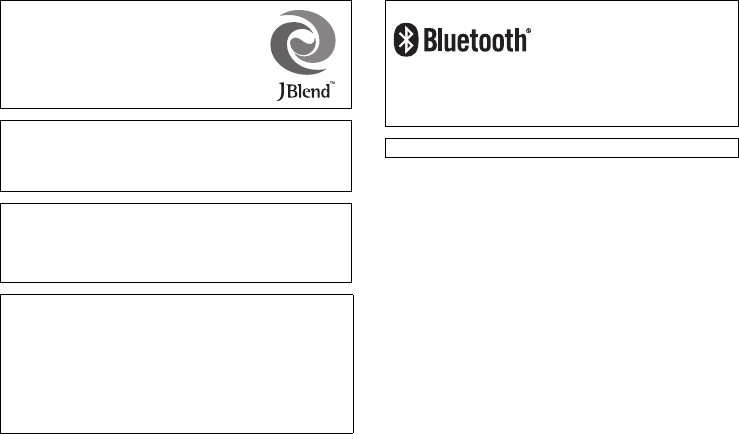
2 Introduction
This product is licensed under the MPEG-4 Visual Patent
Portfolio License for the personal and non-commercial use of
a consumer to (i) encode video in compliance with the
MPEG-4 Video Standard (“MPEG-4 Video”) and/or (ii) decode
MPEG-4 Video that was encoded by a consumer engaged in
a personal and non-commercial activity and/or was obtained
from a licensed video provider. No license is granted or
implied for any other use. Additional information may be
obtained from MPEG LA. See http://www.mpegla.com.
This product is licensed under the MPEG-4 Systems Patent
Portfolio License for encoding in compliance with the MPEG-
4 Systems Standard, except that an additional license and
payment of royalties are necessary for encoding in
connection with (i) data stored or replicated in physical media
which is paid for on a title by title basis and/or (ii) data which
is paid for on a title by title basis and is transmitted to an end
user for permanent storage and/or use. Such additional
license may be obtained from MPEG LA, LLC. See http://
www.mpegla.com for additional details.
Powered by JBlend™ Copyright 1997-
2004 Aplix Corporation. All rights reserved.
JBlend and all JBlend-based trademarks
and logos are trademarks or registered
trademarks of Aplix Corporation in Japan
and other countries.
Powered by Mascot Capsule®/Micro3D Edition™
Mascot Capsule® is a registered trademark of HI
Corporation
©2002-2007 HI Corporation. All Rights Reserved.
Licensed by Inter Digital Technology Corporation under one
or more of the following United States Patents and/or their
domestic or foreign counterparts and other patents
pending, including U.S. Patents: 4,675,863: 4,779,262:
4,785,450 & 4,811,420.
T9 Text Input is licensed under one or more of the following:
U.S. Pat. Nos. 5,818,437, 5,953,541, 5,187,480, 5,945,928,
and 6,011,554; Australian Pat. No. 727539; Canadian Pat.
No. 1,331,057; United Kingdom Pat. No. 2238414B; Hong
Kong Standard Pat. No. HK0940329; Republic of Singapore
Pat. No. 51383; Euro. Pat. No. 0 842 463 (96927260.8) DE/
DK, FI, FR, IT, NL,PT.ES,SE,GB; Republic of Korea Pat.
Nos. KR201211B1 and KR226206B1; and additional
patents are pending worldwide.
Bluetooth is a trademark of the Bluetooth SIG, Inc.
The Bluetooth word mark and logos are owned by the
Bluetooth SIG, Inc. and any use of such marks by Sharp is
under license. Other trademarks and trade names are
those of their respective owners.
CP8 PATENT
Introduction 3
Useful Functions and Services
Your phone offers you the following features:
• A built-in digital camera for taking pictures and
video clips.
• A message function for reading and creating SMS
messages.
• MMS (Multimedia Messaging Services) for
personalising your phone in various ways.
• A WAP browser for accessing information on the
mobile Internet.
• Java™ applications. You can also download various
applications from Vodafone via the mobile Internet.
• The external display for quickly checking the
information of incoming calls or messages.
• Email for sending up to 2000 characters and
receiving mail with attachments.
• A voice recorder function for recording and playing
back voice clips.
•A Bluetooth® wireless technology interface for
establishing contact and transmitting data with
certain devices. You can transmit pictures, sounds,
and video clips to OBEX-enabled phones.
• A data synchronisation function for synchronising
the Contacts List and schedule entries with Microsoft
Outlook or Outlook Express on a PC.
• A schedule alarm for creating and sending schedule
entries with alarm settings.
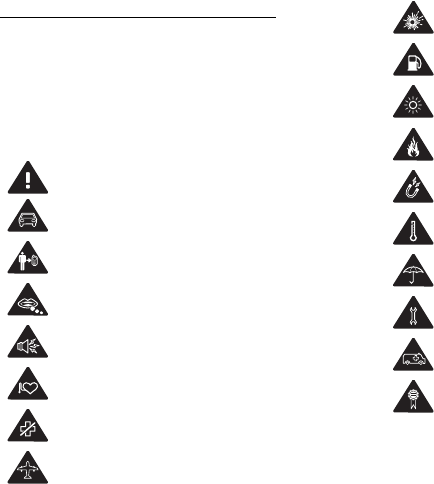
4 SAFETY PRECAUTIONS
SAFETY PRECAUTIONS
Your phone conforms to international regulations in so
far as it is used under normal conditions and in
accordance with the following instructions.
Sharp and Vodafone disclaim any liability for damage
which may result as a consequence of improper use or
use contrary to the instructions contained herein.
Read the safety information sections of this user
guide on pages 4 to 15.
Do not use hand-held while driving.
For body-worn operation, maintain a separation of
1.5 cm.
Small parts may cause a choking hazard.
This device may produce a loud sound.
Keep away from pacemakers and other personal
medical devices.
Switch off when instructed in hospitals and medical
facilities.
Switch off when instructed in aircrafts and airports.
Switch off in explosive environments.
Do not use while re-fuelling.
This device may produce a bright or flashing light.
(* The flashing light feature is not available on all
products.)
Do not dispose of in a fire.
Avoid contact with magnetic media.
Avoid extreme temperatures.
Avoid contact with liquid, keep dry.
Do not attempt to disassemble.
Do not rely on this device for emergency
communications.
Only use approved accessories.

SAFETY PRECAUTIONS 5
RADIOFREQUENCY (RF) EXPOSURE
General Statement on RF Energy
Your phone contains a transmitter and a receiver. When
it is ON, it receives and transmits RF energy. When you
communicate with your phone, the system handling
your call controls the power level at which your phone
transmits.
Specific Absorption Rate (SAR)
Your mobile device is a radio transmitter and receiver.
It is designed not to exceed the limits for exposure to
radio waves recommended by international guidelines.
These guidelines were developed by the independent
scientific organization ICNIRP and include safety
margins designed to assure the protection of all persons,
regardless of age and health.
The guidelines use a unit of measurement known as the
Specific Absorption Rate, or SAR. The SAR limit for
mobile devices is 2 W/kg and the highest SAR value for
this device when tested at the ear was X.XXX W/kg*.
As mobile devices offer a range of functions, they can
be used in other positions, such as on the body as
described in this user guide**. In this case, the highest
tested SAR value is X.XXX W/kg.
As SAR is measured utilising the device’s highest
transmitting power, the actual SAR of this device while
operating is typically below that indicated above. This
is due to automatic changes to the power level of the
device to ensure it only uses the minimum level
required to communicate with the network.
* The tests are carried out in accordance with
international guidelines for testing.
** Please see the section below about body worn
operation.
Body Worn Operation
Important safety information regarding radiofrequency
radiation (RF) exposure:
• To ensure compliance with RF exposure guidelines
the phone must be used with a minimum of 1.5 cm
separation from the body.
• Failure to observe these instructions could result in
your RF exposure exceeding the relevant guideline
limits.

6 SAFETY PRECAUTIONS
Limiting Exposure to Radiofrequency (RF)
Fields
For individuals concerned about limiting their exposure
to RF fields, the World Health Organisation (WHO)
provides the following advice:
• Precautionary measures: Present scientific
information does not indicate the need for any special
precautions for use of mobile phones. If individuals
are concerned, they might choose to limit their own
or their children’s RF exposure by limiting the length
of calls, or using ‘hands-free’ devices to keep mobile
phones away from the head and body.
• For further information readers are referred to:
http://www.who.int/
FCC Notice
This device complies with part 15 of the FCC Rules.
Operation is subject to the following two conditions:
(1) This device may not cause harmful interference, and
(2) this device must accept any interference received,
including interference that may cause undesired
operation.
Changes or modifications not expressly approved by
the manufacturer responsible for compliance could
void the user’s authority to operate the equipment.
Exposure to Radio Waves
THIS MODEL PHONE MEETS THE
GOVERNMENT’S REQUIREMENTS FOR
EXPOSURE TO RADIO WAVES.
Your wireless phone is a radio transmitter and receiver.
It is designed and manufactured not to exceed the
emission limits for exposure to radio frequency (RF)
energy set by the Federal Communications
Commission of the U.S. Government. These limits are
part of comprehensive guidelines and establish
permitted levels of RF energy for the general
population. The guidelines are based on standards that
were developed by independent scientific organizations
through periodic and thorough evaluation of scientific
studies. The standards include a substantial safety
margin designed to assure the safety of all persons,
regardless of age and health.
SAFETY PRECAUTIONS 7
The exposure standard for wireless mobile phones
employs a unit of measurement known as the Specific
Absorption Rate, or SAR. The SAR limit set by the
FCC is 1.6 W/kg.* Tests for SAR are conducted using
standard operating positions specified by the FCC with
the phone transmitting at its highest certified power
level in all tested frequency bands. Although the SAR
is determined at the highest certified power level, the
actual SAR level of the phone while operating can be
well below the maximum value. This is because the
phone is designed to operate at multiple power levels so
as to use only the power required to reach the network.
In general, the closer you are to a wireless base station
antenna, the lower the power output.
Before a phone model is available for sale to the public,
it must be tested and certified to the FCC that it does not
exceed the limit established by the government-adopted
requirement for safe exposure. The tests are performed
in positions and locations (e.g., at the ear and worn on
the body) as required by the FCC for each model. The
highest SAR value for this model phone when tested for
use at the ear is 0.949 W/kg and when worn on the
body, as described in this user guide, is 0.592 W/kg.
Body-worn Operation; This device was tested for
typical body-worn operations with the back of the
phone kept 1.5 cm from the body. To maintain
compliance with FCC RF exposure requirements, use
accessories that maintain a 1.5 cm separation distance
between the user’s body and the back of the phone. The
use of belt-clips, holsters and similar accessories should
not contain metallic components in its assembly.
The use of accessories that do not satisfy these
requirements may not comply with FCC RF exposure
requirements, and should be avoided. While there may
be differences between the SAR levels of various
phones and at various positions, they all meet the
government requirement for safe exposure.
The FCC has granted an Equipment Authorization for
this model phone with all reported SAR levels
evaluated as in compliance with the FCC RF emission
guidelines. SAR information on this model phone is on
file with the FCC and can be found under the Display
Grant section of http://www.fcc.gov/oet/fccid after
searching on FCC ID APYHRO00058.
Additional information on Specific Absorption Rates
(SAR) can be found on the Cellular
Telecommunications & Internet Association (CTIA)
web-site at http://www.phonefacts.net.
* In the United States and Canada, the SAR limit for
mobile phones used by the public is 1.6 watts/kg (W/
kg) averaged over one gram of tissue. The standard
incorporates a substantial margin of safety to give
additional protection for the public and to account for
any variations in measurements.

8 SAFETY PRECAUTIONS
INFORMATION ON PROPER
DISPOSAL
A. Information on Disposal for Users (private
households)
1. In the European Union
Attention: If you want to dispose of this equipment,
please do not use the ordinary dust bin!
Used electrical and electronic equipment must be
treated separately and in accordance with legislation
that requires proper treatment, recovery and recycling
of used electrical and electronic equipment.
Following the implementation by member states,
private households within the EU states may return
their used electrical and electronic equipment to
designated collection facilities free of charge*. In some
countries* your local retailer may also take back your
old product free of charge if you purchase a similar new
one.
*) Please contact your local authority for further details.
If your used electrical or electronic equipment has
batteries or accumulators, please dispose of these
separately beforehand according to local requirements.
By disposing of this product correctly you will help
ensure that the waste undergoes the necessary
treatment, recovery and recycling and thus prevent
potential negative effects on the environment and
human health which could otherwise arise due to
inappropriate waste handling.
2. In other Countries outside the EU
If you wish to discard this product, please contact your
local authorities and ask for the correct method of
disposal.
For Switzerland: Used electrical or electronic
equipment can be returned free of
charge to the dealer, even if you don’t
purchase a new product. Further
collection facilities are listed on the
homepage of www.swico.ch or
www.sens.ch.
Attention: Your product is marked with this symbol.
It means that used electrical and
electronic products should not be mixed
with general household waste. There is a
separate collection system for these
products.

SAFETY PRECAUTIONS 9
B. Information on Disposal for Business Users
1. In the European Union
If the product is used for business purposes and you
want to discard it:
Please contact your SHARP dealer who will inform you
about the take-back of the product. You might be
charged for the costs arising from take-back and
recycling. Small products (and small amounts) might
be taken back by your local collection facilities.
For Spain: Please contact the established collection
system or your local authority for take-
back of your used products.
2. In other Countries outside the EU
If you wish to dispose of this product, please contact
your local authorities and ask for the correct method of
disposal.
DISTRACTIONS
Driving
Full attention must be given to driving at all times in
order to reduce the risk of an accident. Using a phone
while driving (even with a handsfree kit) causes
distraction and can lead to an accident. You must
comply with local laws and regulations restricting the
use of wireless devices while driving.
Operating Machinery
Full attention must be given to operating the machinery
in order to reduce the risk of an accident.

10 SAFETY PRECAUTIONS
PRODUCT HANDLING
General Statement on Handling and Use
You alone are responsible for how you use your phone
and any consequences of its use.
• You must always switch off your phone wherever the
use of a phone is prohibited. Use of your phone is
subject to safety measures designed to protect users
and their environment.
• Always treat your phone and its accessories with care
and keep it in a clean and dust-free place.
• Do not expose your phone or its accessories to open
flames or lit tobacco products.
• Do not expose your phone or its accessories to liquid,
moisture or high humidity.
• Do not drop, throw or try to bend your phone or its
accessories.
• Do not use harsh chemicals, cleaning solvents, or
aerosols to clean the device or its accessories.
• Do not paint your phone or its accessories.
• Do not attempt to disassemble your phone or its
accessories. Only authorised personnel must do so.
• Please check local regulations for disposal of
electronic products.
• Do not carry your phone in your back pocket as it
could break when you sit down.
Small Children
Do not leave your phone and its accessories within the
reach of small children or allow them to play with it.
They could hurt themselves or others, or could
accidentally damage the phone.
Your phone contains small parts with sharp edges that
may cause an injury or which could become detached
and create a choking hazard.
Demagnetisation
To avoid the risk of demagnetisation, do not allow
electronic devices or magnetic media close to your
phone for a long time.
Electrostatic Discharge (ESD)
Do not touch the SIM card’s metal connectors.
Antenna Care
Do not cover the built-in antenna (p. 24, No. 19) with
your hand when using the phone as this may interfere
with the performance.
If you cover it, call quality may deteriorate, and may
shorten talk and standby times because the mobile
phone has to operate on a higher power level than is
necessary.

SAFETY PRECAUTIONS 11
Normal Use Position
When placing or receiving a phone call, hold your
phone to your ear, with the bottom towards your mouth
or as you would a fixed line phone.
Air Bags
• Do not place a phone in the area over an air bag or in
the air bag deployment area.
• Store the phone safely before driving your vehicle.
Seizures/Blackouts
If your phone is capable of producing bright flashing
lights, please be careful because it may trigger seizures
or blackouts.
Repetitive Motion Injuries
To minimise the risk of RSI (Repetitive strain injury),
when texting or playing games with your phone:
• Do not grip the phone too tightly.
• Press the buttons lightly.
• Make use of the special features in the handset which
minimise the number of buttons which have to be
pressed, such as message templates and predictive
text.
• Take lots of breaks to stretch and relax.
Emergency Calls
This phone, like any wireless phone, operates using
radio signals, which cannot guarantee connection in all
conditions. Therefore, you must never rely solely on
any wireless phone for emergency communications.
Loud Noise
This phone is capable of producing loud noises which
may damage your hearing.
Bright Light
If your phone is capable of producing a bright light, do
not use it too close to the eyes.
Phone Heating
Your phone may become warm during charging and
during normal use.

12 SAFETY PRECAUTIONS
ELECTRICAL SAFETY
Accessories
• Use your phone only with batteries, chargers and
accessories recommended by the manufacturer. The
manufacturer disclaims any liability for damage
caused by the use of other chargers, batteries or
accessories.
• Before connecting the phone with a PC or a
peripheral unit, read the operation manual for the
other unit carefully.
• Do not touch the battery terminals. Batteries can
cause damage, injury or burns if a conductive
material touches exposed terminals. When the battery
is detached from the phone, use a cover made of
non-conductive material for keeping and carrying the
battery safely.
Connection to a Car
Seek professional advice when connecting a phone
interface to the vehicle electrical system.
Faulty and Damaged Products
• Do not attempt to disassemble the phone or its
accessory.
• Only qualified personnel must service or repair the
phone or its accessory.
• If your phone or its accessory has been submerged in
water, punctured, or subjected to a severe fall, do not
use it until you have taken it to be checked at an
authorised service centre.
INTERFERENCE
General Statement on Interference
Care must be taken when using the phone in close
proximity to personal medical devices, such as
pacemakers and hearing aids.

SAFETY PRECAUTIONS 13
Pacemakers
Pacemaker manufacturers recommend that a minimum
separation of 15 cm be maintained between a mobile
phone and a pacemaker to avoid potential interference
with the pacemaker. To achieve this, use the phone on
the opposite ear to your pacemaker and do not carry it
in a breast pocket.
Hearing Aids
• People with hearing aids or other cochlear implants
may experience interfering noises when using
wireless devices or when one is nearby.
• Since the level of interference will depend on the type
of hearing device and the distance from the
interference source, increasing the separation
between them may reduce the interference. You may
also consult your hearing aid manufacturer to discuss
alternatives.
Medical Devices
Please consult your doctor and the device manufacturer
to determine if operation of your phone may interfere
with the operation of your medical device.
Hospitals
Switch off your wireless device when requested to do
so in hospitals, clinics or health care facilities. These
requests are designed to prevent possible interference
with sensitive medical equipment.
Aircraft
• Switch off your wireless device whenever you are
instructed to do so by airport or airline staff.
Interference in Cars
Please note that because of possible interference to
electronic equipment, some vehicle manufacturers
forbid the use of mobile phones in their vehicles unless
a handsfree kit with an external antenna is included in
the installation.

14 SAFETY PRECAUTIONS
EXPLOSIVE ENVIRONMENTS
Petrol Stations and Explosive Atmospheres
• In locations with potentially explosive atmospheres,
obey all posted signs to turn off wireless devices such
as your phone or other radio equipment.
• Areas with potentially explosive atmospheres
include fuelling areas, below decks on boats, fuel or
chemical transfer or storage facilities, areas where
the air contains chemicals or particles, such as grain,
dust, or metal powders.
Blasting Caps and Areas
To avoid interfering with blasting operations, turn off
your mobile phone or wireless device when in a
blasting area or in areas posted “turn off two-way radios
or electronic devices”.

CONDITIONS OF USE 15
CONDITIONS OF USE
Battery
•Network configuration and phone usage will
affect talk-time and standby time.
Using the games or camera will hasten battery
consumption.
•When the battery charging alert is displayed on
the screen, charge the battery as soon as possible.
If you continue using your phone ignoring the alert,
the phone may cease to function, and all data and
settings you have stored may be lost.
• Before removing the battery from the phone, make
sure the phone is switched off.
• Replace and charge the new battery as soon as
possible after removing the old one.
• Recommended temperature for using and storing
batteries is approximately 20°C.
• The batteries’ performance is limited in low
temperatures, particularly below 0°C and the phone
may not work temporarily regardless of the amount
of remaining battery power.
• The battery can be charged and discharged hundreds
of times but it will eventually wear out. When the
operating time (talk-time and standby time) is
noticeably shorter than normal, it is time to buy a new
battery.
CAUTION
RISK OF EXPLOSION IF BATTERY IS REPLACED
BY AN INCORRECT TYPE,
DISPOSE OF USED BATTERIES ACCORDING
TO THE INSTRUCTIONS
See “Battery Disposal” on page 26.
Camera Operation
• Learn picture quality, file formats, etc. beforehand.
The taken pictures can be saved in JPEG format.
• Be careful not to move your hand while taking
pictures.
If the phone moves while taking a picture, the picture
can become blurred. When taking a picture, hold the
phone firmly to prevent it from moving, or use the
delay timer.
• Clean the lens cover before taking a picture.
Fingerprints, oils, etc. on the lens cover hinder clear
focusing. Wipe them off with a soft cloth before
taking a picture.
Others
• As with any electronic storage unit, data may be lost
or corrupted under various circumstances.
• If the phone’s battery has been removed for some
time, or the phone has been reset, the unit’s clock and
calendar may be reinitialised. The date and time
should be updated in this case.
• Use only specified handsfree kits (supplied or
optional). Some phone’s functions may not work
when unauthorised handsfree kit is used.

16 Table of Contents
Table of Contents
Introduction ................................................. 1
Useful Functions and Services .................... 3
SAFETY PRECAUTIONS ............................. 4
RADIOFREQUENCY (RF) EXPOSURE .. 5
INFORMATION ON PROPER
DISPOSAL................................................... 8
DISTRACTIONS ........................................ 9
PRODUCT HANDLING .......................... 10
ELECTRICAL SAFETY .......................... 12
INTERFERENCE ..................................... 12
EXPLOSIVE ENVIRONMENTS ............. 14
CONDITIONS OF USE ............................... 15
List of Menu Functions ............................. 19
Your Phone ................................................ 21
Optional Accessories ................................. 21
Getting Started .......................................... 22
Inserting the SIM Card and the Battery .... 25
Charging the Battery ................................. 27
Connecting the Handsfree Kit ................... 28
Turning Your Phone On and Off ............... 28
Display Indicators (Main Display) ............ 29
Display Indicators (External Display) ....... 31
Navigating Functions ................................32
Call Functions ............................................33
Making a Call ............................................ 33
Speed Dialling ........................................... 33
Redialling ................................................... 34
Answering a Call ....................................... 34
Incall Menu ................................................ 35
Entering Characters ..................................39
Changing the Input Languages .................. 39
Changing the Input Method ....................... 40
Using Text Templates ................................ 41
Using the Menu ..........................................42
Contacts .....................................................43
Contacts List .............................................. 43
Selecting the Storage Memory .................. 43
Changing the List Displayed ..................... 43
Changing the Name Order ......................... 44
Add New Contact ...................................... 44
Copying Contacts List Entries
between SIM Card and Handset ................ 45
Table of Contents 17
Finding a Name and Number ..................... 45
Dialling from the Contacts List ................. 46
Editing Contacts List Entries ..................... 46
Deleting Contacts List Entries ................... 46
Viewing Groups ......................................... 46
Group Call ................................................. 47
Assigning a Ringtone to
Each Contacts List Entry ........................... 48
Memory Status ........................................... 48
Speed Dial List .......................................... 48
Sending a Contacts List Entry ................... 49
Receiving a Contacts List Entry ................ 49
Dialling a Service Phone Number ............. 50
Call Log ..................................................... 51
Speed Dial List .......................................... 52
My Numbers .............................................. 52
Call Timers ................................................ 52
Data Counter .............................................. 52
Call Costs ................................................... 53
Camera ....................................................... 54
Take Picture ............................................... 54
Record Video ............................................. 58
Messages ...................................................62
Multimedia (MMS) ....................................62
Text (SMS) .................................................68
Email ..........................................................71
Cell Broadcasts ..........................................73
Vodafone live! ............................................ 74
Starting the WAP Browser .........................74
Navigating a WAP Page ............................75
My Items .....................................................78
Pictures .......................................................78
Games & More ...........................................80
Sounds ........................................................81
Videos ........................................................83
Text Templates ...........................................86
Memory Status ...........................................86
Games & More ........................................... 87
Applications ...............................................87
Screensavers ...............................................88
More Games ...............................................88
Settings .......................................................89
Java™ Information .....................................90
Applications ............................................... 91
SIM Application .........................................91
18 Table of Contents
Alarms ....................................................... 91
Calculator .................................................. 92
Voice Recorder .......................................... 93
Phone Help ................................................ 94
Calendar ..................................................... 95
Settings ...................................................... 98
Connectivity .............................................. 98
Profiles .................................................... 101
Setting the Display .................................. 108
Sound ....................................................... 111
Call Settings ............................................ 111
Date & Time ............................................ 116
Changing the Language ........................... 117
Network ................................................... 117
Security .................................................... 121
Master Reset ............................................ 122
Connecting GX33 to Your PC ................. 123
System Requirements .............................. 123
GSM/GPRS Modem ................................ 123
Handset Manager ..................................... 125
Troubleshooting ...................................... 127
Index ......................................................... 130
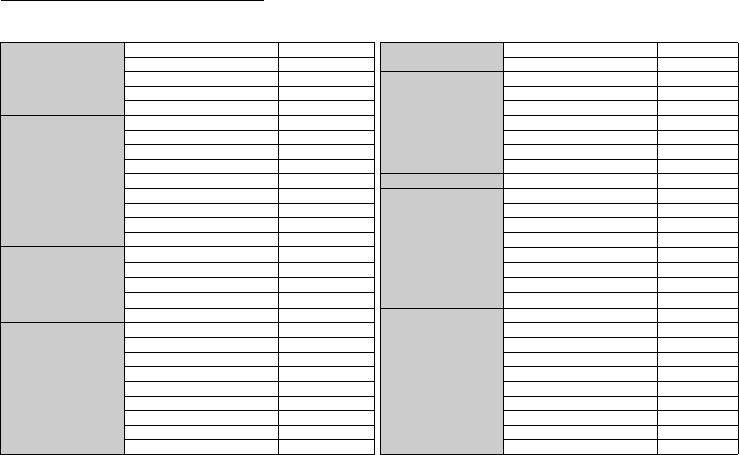
Table of Contents 19
List of Menu Functions
GX33 functions are listed below.
See relevant page for details of each function. The menu’s corresponding number is used for shortcuts. For details, see page 42.
1Games & More
1Applications (p. 87) 5Camera 1Take Picture (p. 54)
2Screensavers (p. 88) 2Record Video (p. 58)
3More Games (p. 88)
6My Items
1Pictures (p. 78)
4Settings (p. 89) 2Games & More (p. 80)
5Java™ Information (p. 90) 3Sounds (p. 81)
2Vodafone live!
1Vodafone live! (p. 74) 4Videos (p. 83)
2Games - 5Text Templates (p. 86)
3Ringtones - 6Bookmarks -
4Pictures - 7Memory Status (p. 86)
5News - 7Calendar (p. 95)
6Sport -
8Contacts
1Contacts List (p. 43)
7Find & Seek - 2Call Log (p. 51)
8Chat - 3Speed Dial List (p. 52)
9Search - 4My Numbers (p. 52)
3Applications
1SIM Application*(p. 91) 5Call Timers (p. 52)
2Alarms (p. 91) 6Data Counter (p. 52)
3Calculator (p. 92) 7Call Costs*(p. 53)
4Voice Recorder (p. 93) 8Service Dialling No.*(p. 50)
5Phone Help (p. 94)
9Settings
1Connectivity (p. 98)
4Messages
1Create Message (p. 62, 69, 71) 2Profiles (p. 101)
2Multimedia (p. 62) 3Display (p. 108)
3Text (p. 68) 4Sound (p. 111)
4Email (p. 71) 5Call Settings (p. 111)
5Media Album - 6Date & Time (p. 116)
6Vodafone Mail - 7Language (p. 117)
7Messenger - 8Network (p. 117)
8Cell Broadcasts (p. 73) 9Security (p. 121)
9Area Info - 0Master Reset (p. 122)
* Depends on SIM card contents.
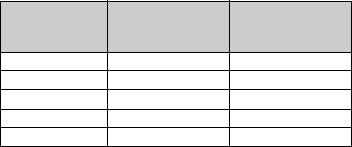
20 Table of Contents
Note for the menu references for the Postcard and
Media Album services
• The menu references for the Postcard and Media
Album services vary in the United Kingdom and
Ireland as follows:
Current
references in
the User Guide
References in
United Kingdom
References in
Ireland
“Postcard” “live! Postcard” (Not available)
“As Postcard” “As live! Postcard” (Not available)
“State/Province” “County” “State/Province”
“Media Album” “live! Studio” “Picture Album”
“To Album” “To live! Studio” “To Picture Album”

Your Phone 21
Your Phone
Please check the following carefully. Your phone
should come complete with:
• GSM 900/1800/1900 GPRS phone
• Rechargeable Li-ion Battery
• AC Charger
• Handsfree Kit
•CD-ROM
•User Guide
• Quick Start Guide*
* This item is not provided in some areas.
Optional Accessories
• Li-ion Spare Battery (XN-1BT33)
• Cigarette Lighter Charger (XN-1CL30)
• USB Data Cable (XN-1DC30)
• AC Charger (XN-1QC30, XN-1QC31)
• Personal Hands-free Kit (XN-1ER33)
The above accessories may not be available in all
regions.
For details, please contact your dealer.
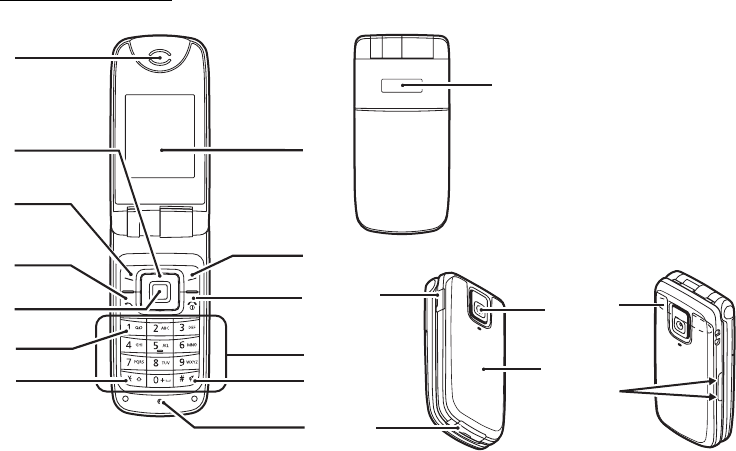
22 Getting Started
Getting Started
2
3
4
5
8
9
10
13
1
6
712
11
14
15
16
18
17
20
19
Getting Started 23
1. Earpiece/Speaker
2. Navigation Keys (Arrow Keys):
Moves cursor to select
menu items, etc.
Up/Down arrow keys:
a b
Displays Contacts List
entries in standby mode.
Left arrow key:
c
Displays list of
Applications in standby
mode.
Right arrow key:
d
Displays list of Saved
Pictures in standby mode.
3. Left Soft Key:
A
Executes the function at the
bottom left of the screen.
4. Send Key:
D
Makes or accepts calls,
views the call logs in
standby mode.
5. Centre Key:
e
Displays Main menu in
standby mode and executes
functions.
6. Voice Mail Key:
G
Press and hold this key to
connect to the Voice mail
centre automatically.
(Depends on the SIM card.)
7. */Shift Key:
P
Switches character case
among four modes: Abc,
ABC, 123 and abc.
Press and hold this key on
the text entry screen to shift
the text input method
between multi-tap and T9
mode.
8. Main Display
9. Right Soft Key:
C
Executes the function at the
bottom right of the screen.
Used to access “Vodafone
live!” by opening the
browser in standby mode.
10.End/Power Key:
F
Ends a call, turns power on/
off.
11.Keypad
24 Getting Started
12.#/Silent Key:
R
Switches symbol screens.
Press and hold this key on
the text entry screen to
display the language
options screen.
Press and hold this key
during standby to switch
Profiles settings between
Normal and Silent mode.
Press e, then R during
standby to turn the
Bluetooth wireless function
on or off.
13.Microphone
14.External Display
15.Handsfree Kit Connector
16.External Connector:
Used to connect either the
charger or USB Data
Cable.
17.Camera
18.Battery Cover
19.Built-in Antenna: Warning: Do not cover the
hinge area of the phone
with your hand when in use
as this may interfere with
the performance of the
built-in antenna.
20.Side-Up/Side-Down Keys:
V WMoves cursor to select
menu items, adjusts
earpiece volume, etc.
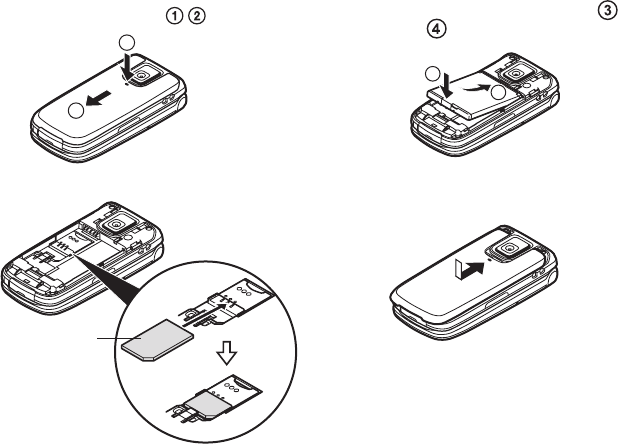
Getting Started 25
Inserting the SIM Card and the
Battery
1. Slide off the battery cover ( ).
2. Slide the SIM card into the SIM holder.
3. Hold the battery so that the metal contacts of the
battery are facing down, slide the guides on the top
of the battery into the battery slots , and then
insert it .
4. Replace the battery cover and slide it as shown
below.
Note
• Make sure that only 3V SIM cards are used.
• Make sure that the standard accessory battery
(XN-1BT33) is used.
2
1
SIM card
4
3
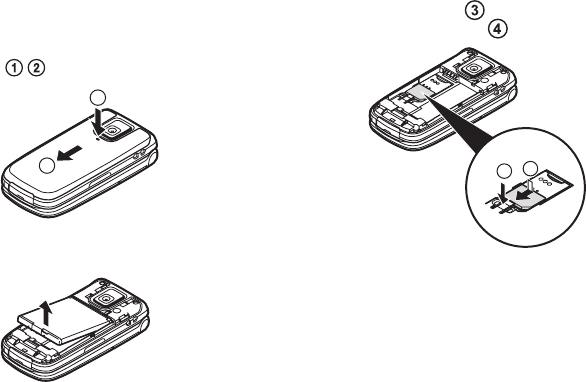
26 Getting Started
Removing the SIM Card and the Battery
1. Make sure to turn off your phone and disconnect the
charger and other accessories. Slide off the battery
cover ( ).
2. Pick up the battery using the protruding edge and
remove the battery from the phone.
3. Hold down gently while sliding the SIM card
out of the SIM holder .
Battery Disposal
In order to protect the environment, please read the
following points concerning battery disposal:
• Take the used battery to your local waste depot,
dealer or customer service centre for recycling.
• Do not expose the used battery to an open flame, into
water or dispose with the household waste.
2
1
4
3
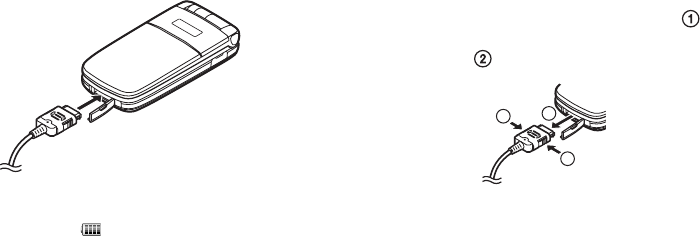
Getting Started 27
Charging the Battery
You must charge the battery for at least 2 hours before
using your phone for the first time.
Using the Charger
1. Open the cover of the external connector, and
connect the charger to the external socket located at
the bottom of the phone until it clicks.
2. Connect the charger to an AC outlet.
When the phone is charging, the animated battery
status icon ( ) in the upper right of the screen
displays the current status.
Standard charging time: Approx. 2 hours.
Note
• Charging time may vary depending on the state of the
battery and other conditions. (See “Battery” on
page 15.)
To Disconnect the Charger
When charging is complete, the battery indicator icon
displays the full charge status.
1. Unplug the charger from the AC outlet.
2. Push and hold the side buttons of the charger ,
then disconnect the charger from the external socket
of the phone .
Note
• Do not use any non-approved chargers as they may
damage your phone and invalidate any warranties,
see “Battery” on page 15 for details.
• Forcibly disconnecting the charger may cause
malfunction.
2
1
1
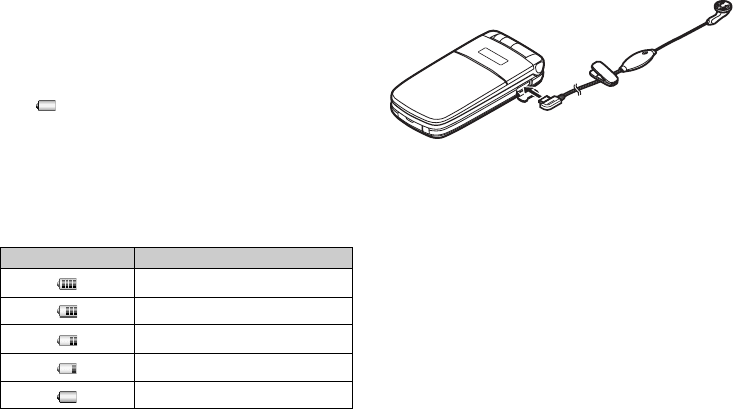
28 Getting Started
To Charge Using the Cigarette Lighter Charger
The optional Cigarette Lighter Charger supplies power
for charging from the cigarette lighter socket of a car.
Battery Level Indicator
The current battery level is displayed in the upper right
hand side of the main display and in the external
display.
Low Battery During Use
When the battery is running low, an alarm will sound
and “ ” is displayed on the main display and the
external display.
If you are using your phone and you hear the “low
battery” alarm, attach your charger as soon as possible.
The phone may not be able to continue normal
operation if you continue to use it. The battery may only
last approximately five minutes before the phone itself
powers down during a call.
Connecting the Handsfree Kit
1. Open the connector cover.
2. Connect the handsfree kit.
Turning Your Phone On and Off
To turn the power on, press and hold F for
approximately 2 seconds.
The standby screen is displayed.
To turn the power off, press and hold F for
approximately 2 seconds.
Battery Indicators Charge Level
Sufficiently charged
Partially charged
Charging recommended
Charging required
Empty
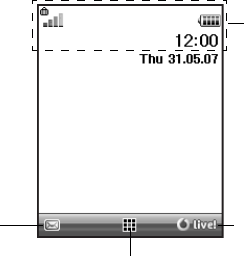
Getting Started 29
To Enter the PIN Code
If the PIN (Personal Identification Number) code is
enabled you are asked to enter the PIN code each time
the phone is switched on. For details on setting the PIN
code, see “Enabling/Disabling the PIN Code” on
page 121.
1. Enter your PIN code.
2. Press e.
Note
• If your PIN code is entered incorrectly three times in
a row, the SIM card is locked. See “Enabling/
Disabling the PIN Code” on page 121.
To Copy Contacts List from the SIM Card
When you insert the SIM card into your phone for the
first time and start the Contacts List application, you are
asked whether you wish to copy Contacts List entries
on the SIM card. Follow the on-screen instructions, or
you can do it later using the Contacts List menu as
follows:
“Contacts”
→
“Contacts List”
→
[Options]
→
“Advanced”
→
“Copy All Entries”
1. Select “From SIM to Handset”.
Display Indicators (Main Display)
Status
indicators
Right soft ke
y
Left soft
key
Centre key
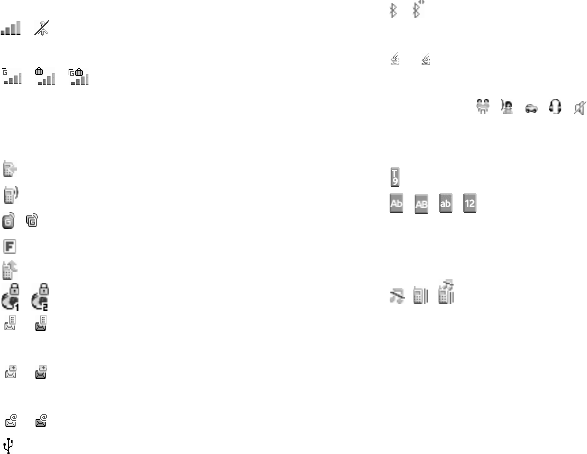
30 Getting Started
Status Indicators
1. / : Strength of received signal/Service out
of range
//:
GPRS within range and enabled/
Roaming outside network/GPRS within
range, enabled and roaming
2. : Call incoming
3. : Call in progress
4. / : CSD/GPRS in progress
5. : Fax communication in progress
6. : “Diverts” (p. 111) set to “All Calls”
7. / : Secure WAP page displayed
8. / : Text message alerts [unread/mailbox
full]
9. / : Multimedia message alerts [unread/
mailbox full]
10. / : Email alerts [unread/mailbox full]
11. : USB Data Cable connected
12. / : Bluetooth wireless setting [enabled/
communicating]
13. / : Java™ application [executed (colour)/
suspended (grey)]
14. (No display)/ / / / / :
Current profile [Normal/Meeting/
Activity/Car/Headset/Silent]
15. : T9 text input method enabled
16. / / / :
Current text input method [First letter
upper case/Upper case/Lower case/
Numeric]
17. / / :“Ringer Volume” (p. 102) set to
“Silent”/Vibration enabled (p. 103)/
Vibration enabled and sound
deactivated
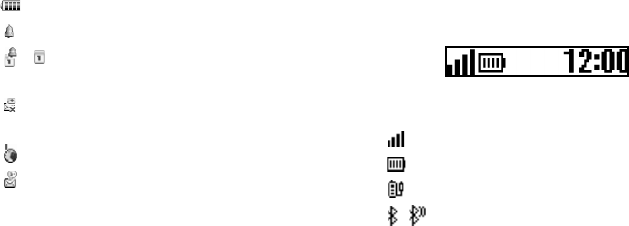
Getting Started 31
18. : Battery level
19. : Daily alarm enabled
20. / : Schedule entry enabled [with/without a
reminder alarm]
21. : Outbox contains unsent multimedia
messages
22. : WAP alert
23. : Voicemail message alert
Display Indicators (External Display)
Status Indicators
1. : Strength of received signal
2. : Battery level
3. : USB Data Cable connected
4. / :
Bluetooth
wireless connection [enabled/
communicating]

32 Navigating Functions
Navigating Functions
All applications are accessed from the Main menu. To
open the Main menu, press the centre key (e) during
standby.
To launch applications, you will need to highlight menu
items, and make selections. To select a menu item
(indicated in quotation marks), move the cursor using
a, b, c and d, and press e to commit your
selection.
In certain procedures, you will need to press one of the
soft keys (indicated in square brackets), which are
displayed at the bottom left and right of the screen.
Press the corresponding soft key (A or C).
To return to the previous screen, press the right soft key
if it displays “Back”. To close the Main menu, press the
right soft key if it displays “Exit”.
Each section in this User Guide starts with a list of
items you will need to select in order (indicated in
italics) before performing the procedures shown. Select
each item to reveal the next set of items that you have
to select. Open subsection items after opening those
listed in the main section.
Example:
“Contacts”
→
“Contacts List”
→
[Options]
→
“Advanced”

Call Functions 33
Call Functions
Making a Call
1. Enter the area code and the phone number you wish
to dial and press D to dial.
If you enter the wrong number, press [Clear] to
delete the number to the left of the cursor.
Emergency Calls
1. Enter 112 (international emergency number) using
the keypad and press D to dial.
Note
• Emergency calls may not be available on all mobile
phone networks when certain network services and/
or phone features are in use. Contact your network
operator for more information.
• This Emergency number can normally be used to
make an emergency call in any country, with or
without a SIM card inserted, if a GSM network is
within range.
International Calls
1. Press and hold Q until a “+” (international
dialling prefix) sign is displayed.
2. Enter the country code, followed by the area code
(without the leading zero) and the phone number,
and press D to dial.
Speed Dialling
Up to 8 phone numbers from the Contacts List memory
(Handset and SIM) can be assigned to speed dials. You
can call the numbers using the digit keys (H to O).
For details on setting the Speed Dial List, see “Speed
Dial List” on page 48.
1. To dial a number using the speed dial, press and
hold any of the digit keys (H to O).
The phone number stored in the Speed Dial List is
dialled.
34 Call Functions
Redialling
You can redial numbers in the call log. Select from
specific categories or “All Calls”. Specific category
contains up to 10 numbers and the “All Calls” list
contains up to 30.
1. Press D during standby.
2. Press c or d to switch logs between “All Calls”,
“Dialled Numbers”, “Missed Calls” and “Received
Calls”.
3. Highlight the phone number you wish to call.
4. Press D to redial the call.
Automatic Redialling
This setting allows you to automatically redial the
number if the first attempt was unsuccessful because
the called party was busy.
If you wish to stop redialling, press F or [End].
To Set the Auto Redial Function
“Settings”
→
“Call Settings”
→
“Auto Redial”
1. Select “On” or “Off”.
Note
• When you receive an incoming call, the Auto Redial
function is interrupted.
• Automatic redialling is not available for fax and data
calls.
Answering a Call
When an incoming call is detected, the phone rings.
1. Press D, e or [Answer] to answer the call.
Or press any key except F and [Busy] when the
“Any Key Answer” function is enabled. Set the Any
Key Answer function in the profile of each mode.
(p. 107)
Tip
• When the Personal Hands-free Kit (option) is
connected to the phone, you can answer calls by
pressing the Answer button.
• If you have subscribed to the Calling Line
Identification (CLI) service and the caller’s network
sends the number, the caller’s number is displayed on
the screen. If the caller’s name and number are
stored in the Contacts List, the caller’s name and
phone number are displayed on the screen.
• If the number is a restricted number, the display
shows “Withheld”.
• When receiving a call from the person whose picture
is registered in the Contacts List, receiving display
and the picture are displayed alternately.
Call Functions 35
Rejecting an Incoming Call
1. Press F or press and hold the side-up or side-down
key whilst the phone is ringing to reject a call you
do not wish to answer.
Letting the Caller Know You are Unavailable
1. Press [Busy] whilst the phone is ringing to send a
busy tone to the caller of an incoming call letting
them know that you cannot answer the call.
Incall Menu
Your phone has additional functions available whilst a
call is in progress.
Adjusting the Earpiece Volume
During a call, you can adjust the earpiece volume (and
handsfree volume, if connected).
1. During a call, press the side-up or side-down key to
display the Earpiece Volume screen.
2. Press the side-up key (or a/d) to increase the
volume of the call or press the side-down key (or
b/c) to decrease the volume.
Five levels (level 1 to 5) are selectable.
3. Press e when the volume is set to the desired level.
The phone returns to the incall screen automatically
if left unused.
36 Call Functions
Putting a Call on Hold
This function allows you to manage two calls at the
same time. If you wish to make another call whilst you
are talking to someone, you can put the current call on
hold to call someone else.
To Make Another Call during a Call
1. During a call, press [Options].
2. Select “Hold”.
The current call is put on hold.
To retrieve a call, press [Options] and select
“Retrieve”.
3. Enter the phone number you wish to make another
call to, then press D.
Tip
• You can also make another call by entering the phone
number during a call instead of steps 1 and 2. The
current call is automatically put on hold.
Call Waiting
This service notifies you of another incoming call
whilst you have a call in progress.
1. During a call, press [Options] and select “Hold &
Answer” to answer the second call.
The first call is put on hold and you can now talk to
the second caller.
2. Press [Options] and select “Swap Calls” to switch
between the two calls.
3. Press [Options] and select “Release Call” to end the
current call and return to the held call.
Note
• You need to set “Call Waiting” to “On” if you use the
Call Waiting service (p. 112).
• Call Waiting service may not be available on all
networks. Contact your network operator for more
information.
• If you do not wish to answer the second call, press
[Busy], or press [Options] and select “Busy” or
“Reject”, in step 1. If “Reject” is selected, the call
log of the second call is saved as a missed call.
Call Functions 37
Accessing SMS Menu During a Call
1. During a call, press [Options] and select “Text”.
The following options are available: “Create
Message” to create an SMS, or “Inbox”, “Sent” or
“Drafts” to access these folders. For details on SMS,
see “Text (SMS)” on page 68.
Conference Call
Conference call is a call with more than 2 participants.
You may include up to 5 participants in a conference
call.
To Make a Conference Call
To make a conference call, you must have one active
call and one held call.
1. During a call, press [Options] and select
“Multiparty” to answer the second call.
2. Select “Conference All” to join the conference call.
3. Press F to end the conference call.
Note
• Conference call service may not be available on all
networks. Contact your network operator for more
information.
• You have more options for the Conference call in step
2:
• To put all participants on hold, select “Conference
Hold All”.
• To put all participants except the current call on
hold, select “Private”.
• To end the call with all participants, select
“Release All”.
• To disconnect from the conference call but still
allow the other participants to continue talking
together, select “Transfer”.
• To put the current call on hold and continue to
have a conference call with the remaining
participants, select “Exclude”.
• To reject adding more participants to the current
party, select “Reject”, or you can send the busy
tone by selecting “Busy”.
38 Call Functions
To Add New Participants to the Conference Call
1. Press [Options] and select “Dial”.
2. Enter the number you wish to include in the
conference call and press D to dial.
3. Press [Options] and select “Multiparty”.
4. Select “Conference All” to join the conference call.
If you wish to add other participants, repeat steps 1
to 4.
To End the Call with a Conference Call Participant
1. During a conference call, highlight the person that
you wish to disconnect from the conference call.
2. Press [Options] and select “Release Call”.
To Have a Private Conversation with One of the
Participants
If you wish to have a private conversation with one of
the participants, you may select the participant from the
conference list and put the other participants on hold.
1. During a conference call, select the person that you
wish to talk to.
2. Press [Options] and select “Multiparty”.
3. Select “Private”.
4. Once you have finished the private conversation,
press [Options] and select “Multiparty”.
5. Select “Conference All” to return to the conference
call.
Muting the Microphone
1. During a call, press [Mute] to mute the microphone.
To unmute the microphone, press [Unmute].

Entering Characters 39
Entering Characters
When entering characters to create Contacts List
entries, text messages or multimedia messages, etc.,
press the corresponding keys.
In multi-tap input method, press each key until the
desired character is displayed. For example, press H
once for the letter “A” or twice for the letter “B”.
Press the following keys to:
Press and hold the following keys to:
Changing the Input Languages
You can change the input language on the text entry
screen.
1. On the text entry screen, press [Options].
2. Select “Input Language”.
If “Input Language” is not displayed, select “Text
Options” and then select “Input Language”.
3. Select the desired language.
Tip
• You can press and hold R instead of steps 1 and 2
to display the language options screen.
G:enter:
. (full-stop) , (comma) - (hyphen) ? ! ’
(apostrophe) @ :1
Q:enter:
(space)+ = < > € £ $ ¥ % &0
P:switch character case among four modes:
Abc, ABC, 123 and abc.
R:enter other characters.
G-O:
Q
enter 0 - 9 numbers.
P:shift between multi-tap and T9 mode.
R:display the language options screen.
40 Entering Characters
Changing the Input Method
T9 Text Input
T9 text input method is a shortcut to enter text easily
and quickly.
1. On the text entry screen, press and hold P to enter
T9 mode.
2. Press [Options].
3. Select “Input Method”.
If “Input Method” is not displayed, select “Text
Options” and then select “Input Method”.
4. Select the input mode (Abc, ABC, abc, 123).
5. Press each key once for any letter you require on
that key.
To enter the word “How”, press J L O.
6. If the word shown isn’t the one you want, press a
or b until you highlight the correct one.
7. Press e to select the word.
Note
• If the correct word is not shown in step 6, enter the
correct word again after switching to the multi-tap
input method.
Tip
• If you press Q instead of step 7, a space is inserted
next to the selected word.
Symbols and Punctuations
1. On the text entry screen, press [Options].
2. Select “Add Symbol”.
If “Add Symbol” is not displayed, select “Text
Options” and then select “Add Symbol”.
3. Select the desired symbol.
My Dictionary
You can create your own word list for T9 text input.
1. On the text entry screen in T9 mode, press
[Options].
2. Select “My Dictionary”.
If “My Dictionary” is not displayed, select “Text
Options” and then select “My Dictionary”.
3. Select “Add New Word” and enter a new word.
Entering Characters 41
To edit a word in the list
1. On the text entry screen in T9 mode, press
[Options].
2. Select “My Dictionary”.
If “My Dictionary” is not displayed, select “Text
Options” and then select “My Dictionary”.
3. Highlight the desired word.
4. Press [Options] and select “Edit”.
5. Modify the word.
Tip
• You can also carry out the following steps to register
a new word in the list for T9 text input.
1. Enter a (part of) word in T9 mode you wish to
register.
2. Press [Options].
3. Select “My Dictionary”.
If “My Dictionary” is not displayed, select “Text
Options” and then select “My Dictionary”.
4. Modify the word.
Using Text Templates
You can use the sentences registered in Text Templates
when entering characters.
For details on creating the text template, see “Adding
Phrases to Text Templates” on page 86.
1. On the text entry screen, move the cursor to the
point you wish to insert the template.
2. Press [Options].
3. Select “Add Text Template”.
If “Add Text Template” is not displayed, select
“Text Options” and then select “Add Text
Template”.
4. Select the desired text template.
The selected text template is inserted.
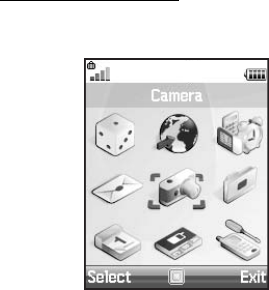
42 Using the Menu
Using the Menu
Accessing Applications
1. Press e during standby.
The Main menu is displayed.
2. Navigate to required location.
3. Press e to access function.
Shortcut Keys
You can shortcut to the specified menus by pressing e
and digit keys for the menu’s corresponding number on
the Main menu. See the List of Menu Functions on
page 19 for reference.
Shortcuts are listed in the headings of this manual. For
example: “M 9-7”.
Example: To Access “Language” Sub Menu
Using Shortcut Keys
Press e O M.
Note
• The shortcut keys work for the first three menu levels
only.

Contacts 43
Contacts
Contacts List
You can store the phone numbers and Email addresses
of your friends, family and colleagues in the Contacts
List.
Depending on the size of the entry, your phone can
store up to approximately 500 entries. In a Contacts
List, you can store the following items.
Items stored in the handset memory
First Name
Last Name
Tel Mobile
Tel Private
Tel Office
Email Private
Email Business
Group
Address (Street & Number, Postal Code, City, State/
Province, Country)
Note
Items stored in the SIM memory
Name: The number of characters that can be
stored differs depending on the SIM
card you use.
Phone: Up to 40 digits
Using the Bluetooth wireless function, you can send the
Contacts List to a PC and save to prevent loss.
Selecting the Storage Memory
“Contacts”
→
“Contacts List”
→
[Options]
→
“Advanced”
→
“Save New Contacts”
1. Select Contacts location from “To Handset”, “To
SIM” or “Choose before Saving”.
Tip
• “Choose before Saving” prompts you to choose the
memory every time you save a new entry.
Changing the List Displayed
“Contacts”
→
“Contacts List”
→
[Options]
→
“Advanced”
→
“Contacts Location”
1. Select from “Handset Memory”, “SIM Memory” or
“Both”.
(M 8)
(M 8-1)
44 Contacts
Changing the Name Order
“Contacts”
→
“Contacts List”
→
[Options]
→
“Advanced”
→
“Name Order”
1. Select from “First - Last name” or “Last - First
name”.
Add New Contact
You can choose either the phone or SIM card memory
locations to store the new entry. For switching
locations, see “Selecting the Storage Memory” on
page 43.
The amount of phone numbers that you can store to the
SIM card is dependent on its capacity. Contact your
network operator for details.
“Contacts”
→
“Contacts List”
→
“Add New Contact”
If you select the “Choose before Saving” option for the
memory to be used, the selection is between “To
Handset” and “To SIM”.
1. Select the field you wish to fill in, and enter the
relevant information.
2. Press [Save] when finished.
Tip
• To create an entry, at least one field must be filled. If
you create a new entry on the SIM card, you need to
enter a phone number.
Adding a Thumbnail to Entries
Only Contacts saved to the handset can have
Thumbnails attached to them.
“Contacts”
→
“Contacts List”
1. Highlight the desired handset entry.
2. Press [Options] and select “Edit/Add Details”.
3. Press [Options] and select “Picture”.
4. Select the desired picture.
5. Press [Save] when finished.
Note
• From the Contacts List entry that has a thumbnail
added, you can change or delete it by selecting
“Change” or “Remove” after step 3.
• If you delete a picture in Saved Pictures, the
corresponding thumbnail is also deleted.
Contacts 45
Copying Contacts List Entries
between SIM Card and Handset
“Contacts”
→
“Contacts List”
→
[Options]
→
“Advanced”
→
“Copy All Entries”
1. Select “From SIM to Handset” or “From Handset to
SIM”.
The confirmation screen appears automatically,
asking you if you wish to copy or not.
Note
• When you insert the SIM card into your phone for the
first time and start the Contacts List application, the
confirmation screen appears automatically, asking
you if you wish to copy or not. The number of
Contacts List entries to be copied varies depending
on the SIM capacity.
Copying a Single Entry from Handset to SIM
Card
“Contacts”
→
“Contacts List”
1. Select the desired entry.
2. Highlight the desired phone number.
3. Press [Options] and select “Copy to SIM”.
Finding a Name and Number
“Contacts”
→
“Contacts List”
1. Enter the first few letters of the name.
Search results are displayed in alphabetical order.
Tip
• You can select the Contacts location from “Handset
Memory”, “SIM Memory” or “Both” before
searching.
• To view the details of the item such as address,
highlight the desired item, press [Options] and select
“View”.

46 Contacts
Dialling from the Contacts List
“Contacts”
→
“Contacts List”
1. Highlight the desired entry and press D.
Tip
• If more than one phone number is registered for the
entry, select the desired phone number after step 1
and press D. You can also dial the desired phone
number by pressing the digit key corresponding to
the position the entry is on the list.
• You can also dial from the details screen of the
Contacts List. On the details screen, select the
desired phone number and press D.
Editing Contacts List Entries
“Contacts”
→
“Contacts List”
→
[Options]
→
“Edit/
Add Details”
1. Select the field you wish to edit, and modify the
information.
2. Press [Save] when finished.
Deleting Contacts List Entries
Deleting All Contact Entries
“Contacts”
→
“Contacts List”
→
[Options]
→
“Advanced”
→
“Delete All Entries”
1. Enter your handset code.
2. Select “Handset Entries” or “SIM Entries”.
The confirmation screen appears automatically,
asking you if you wish to delete or not.
The default handset code is “0000”. For details on
changing the handset code, see “To Change Handset
Code” on page 122.
Deleting a Contact Entry
“Contacts”
→
“Contacts List”
1. Highlight the desired entry.
2. Press [Options] and select “Delete”.
Viewing Groups
You can set group icons when storing Contacts entries
so that you can easily find and edit them.
“Contacts”
→
“Contacts List”
→
[Options]
→
“Advanced”
→
“Group”
→
“View Groups”
1. Select the desired group.
“ ” appears next to the selected group. Select the
group again to cancel, and the checkbox becomes
unchecked.
Contacts 47
Note
• This menu is available when the Contacts location is
set to “Handset Memory”.
Tip
• Press [Options] and select “Current Only” to view
only the selected group or “Select All” to view all
groups.
Group Call
Different ringtones can be set for each group. When
you purchase this phone, groups are set to off. If you do
not set a group ringtone, the ringtone assigned in the
Settings menu is used.
“Contacts”
→
“Contacts List”
→
[Options]
→
“Advanced”
→
“Group”
→
“Group Call”
1. Select the desired group.
2. Select “Switch On/Off”.
3. Select “On” or “Off”.
4. Select “Assign Ringtone”.
5. Select “Preset Sounds” or “My Sounds”.
6. Select the desired ringtone.
For details on selecting a ringtone, see “Assigning
Ringtone” on page 103.
7. Select “Vibration” and select from “On” or “Off”.
For details on selecting a vibration, see “Vibration”
on page 103.
8. Press [OK].
Note
• This menu is available when the Contacts location is
set to “Handset Memory”.
48 Contacts
Assigning a Ringtone to Each
Contacts List Entry
A specified ringtone or vibration setting can be
associated to a pre-registered entry.
“Contacts”
→
“Contacts List”
1. Select the desired entry.
2. Press [Options] and select “Edit/Add Details”.
3. Press [Options] and select “Ringtone”.
4. Select “Switch On/Off”.
5. Select “On” or “Off”.
6. Select “Assign Ringtone”.
7. Select “Preset Sounds” or “My Sounds”.
8. Select the desired ringtone.
For details on selecting a ringtone, see “Assigning
Ringtone” on page 103.
9. Select “Vibration” and select from “On” or “Off”.
For details on selecting a vibration, see “Vibration”
on page 103.
10.Press [OK].
11.Press [Save].
Memory Status
This function helps you to check the memory used in
the Contacts List.
“Contacts”
→
“Contacts List”
→
[Options]
→
“Advanced”
→
“Memory Status”
Speed Dial List
You can set a maximum of 8 phone numbers in the
Speed Dial List (p. 52).
Setting Contacts List Entries in the Speed Dial
List
“Contacts”
→
“Contacts List”
1. Select the desired entry.
2. Highlight the desired phone number.
3. Press [Options] and select “Add to Speed Dial”.
4. Select the desired list number.
Tip
• The nine digit keys correspond to list numbers.
• To view the speed dial list, see page 52.
Contacts 49
Sending a Contacts List Entry
“Contacts”
→
“Contacts List”
1. Highlight the desired entry.
2. Press [Options] and select “Send Contact”.
3. Select “Via Bluetooth”.
For “Via Bluetooth”
The phone starts searching for Bluetooth wireless
technology enabled devices within 10 metres.
When detected, a list of enabled devices is displayed
allowing you to select the desired device. The
connection can be established and the entry is sent.
Note
• When pairing, you need to enter your passcode when
establishing contact with a Bluetooth wireless
technology enabled device for the first time except
when “Authentication” (p. 100) is set to “Off”.
Tip
• You can send your own Contacts List entry. Highlight
“My Card” in step 1. For details on storing your
information in My Card, see “Registering Your
Information as a Contacts List Entry” on page 50.
Receiving a Contacts List Entry
When the phone receives a Contacts List entry, a
confirmation message appears.
1. Press [Yes].
The received entry is registered in the Contacts List.
Press [No] to reject.
Tip
• For details on making Bluetooth wireless settings,
see “Connectivity” on page 98.
50 Contacts
Registering Your Information as a Contacts
List Entry
You can store your information in the Contacts List.
“Contacts”
→
“Contacts List”
→
“My Card”
1. Press [Options] and select “Edit/Add Details”.
2. Select the field you wish to fill in, and enter the
relevant information.
3. Press [Save] when finished.
Dialling a Service Phone Number
Certain SIM cards contain service phone numbers that
can be dialled. Contact your SIM card vendor for more
information. On the Contacts screen, “Service Dialling
No.” is displayed at the bottom of the list.
“Contacts”
1. Select “Service Dialling No.”.
2. Select the desired service phone number.
Tip
• If the SIM card contains only one service phone
number, you can dial it in step 1 by pressing e.
• If no service phone number is stored in the SIM card,
this menu is not displayed.
Contacts 51
Call Log
The phone will record the last 10 missed calls, received
calls and dialled numbers.
Viewing Call Log
“Contacts”
→
“Call Log”
1. Press c or d to switch logs between “All Calls”,
“Dialled Numbers”, “Missed Calls” and “Received
Calls”.
The selected call log list is displayed.
2. Select the phone number you wish to view.
If you wish to dial the number, press D.
Tip
• You can also confirm call logs by pressing D during
standby mode.
Sending Messages
1. In call log list, highlight the call log you wish to
send a message to.
2. Press [Options] and select “Create Message”.
3. Select “Multimedia”, “Text” or “Postcard”.
For details on creating a message, see “Creating a
New MMS” on page 62 or “Creating and Sending a
New SMS” on page 69.
Note
• The Postcard service is not available with some
service providers. Please contact your service
provider for more information.
Deleting a Call Log
1. In call log list, highlight the call log you wish to
delete.
2. Press [Options] and select “Delete”.
(M 8-2)
52 Contacts
Speed Dial List
You can view and perform other operations for phone
numbers registered in the Speed Dial List.
“Contacts”
→
“Speed Dial List”
The names and phone numbers stored in the Speed Dial
List are displayed in order.
My Numbers
You can check your own voice, data and fax phone
numbers.
“Contacts”
→
“My Numbers”
1. Select the phone number you wish to check from
“Voice”, “Data” or “Fax”.
Note
• “Data” or “Fax” may not be displayed depending on
the SIM card.
Call Timers
This function lets you check the duration of your calls.
Checking the Duration of the Last Call and All
Calls
“Contacts”
→
“Call Timers”
1. Select “Received Calls” or “Dialled Numbers”.
The duration of the last call and all calls are
displayed.
Resetting All Call Timers
“Contacts”
→
“Call Timers”
→
“Clear Timers”
Data Counter
You can confirm the amount of bytes that you used in
the GPRS transmission.
“Contacts”
→
“Data Counter”
1. Select from “Last Data” or “All Data”.
Resetting All Data Counter
“Contacts”
→
“Data Counter”
→
“Clear Counter”
(M 8-3)
(M 8-4)
(M 8-5)
(M 8-6)

Contacts 53
Call Costs
This function lets you check the charges for your calls.
Some networks do not support Charging Advice.
Please check with your service provider for
availability.
Checking the Cost of the Last Call
“Contacts”
→
“Call Costs”
→
“Last Call”
The cost of the last call is displayed.
Checking the Total Call Cost
“Contacts”
→
“Call Costs”
→
“All Calls”
The cost of all calls is displayed.
Setting the Charge Rate
Set the charge rate to calculate the call cost and set the
maximum limit for call cost.
“Contacts”
→
“Call Costs”
→
“Costs Units”
→
“Set
Units”
1. Enter your PIN2 code.
2. Enter a cost per unit.
To enter a decimal point, press R.
3. Enter a currency unit (up to 3 characters).
Setting the Charge Limit
This function is useful if you wish to make sure you do
not exceed a certain charge limit.
“Contacts”
→
“Call Costs”
→
“Max Cost”
→
“Set
Limit”
1. Enter your PIN2 code.
2. Enter a value.
To enter a decimal point, press R.
Resetting All Call Costs
“Contacts”
→
“Call Costs”
→
“Clear Costs”
1. Enter your PIN2 code.
Checking the Residual Credit
“Contacts”
→
“Call Costs”
→
“Residual Credit”
(M 8-7)

54 Camera
Camera
Your phone has an integrated digital camera.
This allows you to take and send pictures or video clips
wherever you are.
Take Picture
Put the phone into the digital camera mode to take a
picture. Pictures are saved in Saved Pictures in JPEG
format in the following three picture sizes.
L: 480 × 640 dots
M: 240 × 320 dots
S: 120 × 160 dots
Taking Pictures
“Camera”
→
“Take Picture”
The preview is displayed through the screen.
1. Press e or the side-down key to take the picture.
The shutter sounds and the still image of the taken
picture is displayed. Press [Cancel] to retake a picture.
2. Press [Save].
“Saving (file name) to My Items…” is displayed,
then the picture is registered.
3. Press F to return to standby.
Remaining shots indicator
123: Indicates the remaining number of
pictures that can be taken.
Tip
• If you wish to send a picture by multimedia message
after taking the picture, press e before step 2. Then
select “Multimedia” or “Postcard”. (The Postcard
service is not available with some service providers.
Please contact your service provider for more
information.) Large MMS messages may cause the
size of attached pictures to be reduced.
Using the Full Screen
The preview can be displayed on the full screen without
the soft key area and indicators.
“Camera”
→
“Take Picture”
→
[Options]
→
“Full
Viewfinder”
1. Select “On” or “Off”.
[Options] is not displayed if “On” is selected. Press
A when you need the option menu.
Note
• When “Picture Size” is set to “S”, you cannot use the
full screen.
Tip
•
You can turn on/off full screen mode by pressing
Q
.
(M 5)
(M 5-1)

Camera 55
Using the Zoom Function
Press c or d to change the zooming ratio.
Zooming ratio indicators
: Magnification.
Note
• When “Picture Size” is set to “S”, the zoom function
has 3 magnifications (
×
1,
×
2,
×
4).
• When “Picture Size” is set to “M”, the zoom function
has 2 magnifications (
×
1,
×
2).
Selecting the Picture Size
“Camera”
→
“Take Picture”
→
[Options]
→
“Picture Size”
1. Select the desired picture size.
Selecting the Picture Quality
“Camera”
→
“Take Picture”
→
[Options]
→
“Picture Quality”
1. Select “Normal” or “Fine”.
Picture quality indicators
:Fine
:Normal
Selecting the Anti-flicker Mode
“Camera”
→
“Take Picture”
→
[Options]
→
“Anti-
flicker”
1. Select “Mode 1: 50Hz” or “Mode 2: 60Hz”.
Note
• Vertical stripes may occur on the picture due to the
light source. Change the anti-flicker mode to rectify.
• The digital camera uses a C-MOS sensor. Although
this camera has been manufactured to the highest
specifications, some pictures may still appear too
bright or too dark.
• If the phone has been left in a hot place for a long
time before taking or registering a picture, the
picture quality may be poor.
In the Case of No Available Memory
When the number of pictures that can be taken becomes
3 or less, the remaining shots indicator in the upper left
of the screen turns red. (The number of pictures that can
be taken is approximate.)
When the number of pictures that can be taken becomes
0, and when you try to take a picture again, “Memory
full. Please delete some data!” is displayed.

56 Camera
Adjusting the Brightness of the Picture
According to Lighting Conditions
Press a or b to adjust the brightness of the picture.
Picture brightness (exposure level) indicators
: (Bright → Normal
→
Dark)
Once the phone has returned to the standby screen, the
brightness settings return to default.
Viewing the Taken Pictures
“Camera”
→
“Take Picture”
→
[Options]
→
“My
Pictures”
The list of pictures is displayed.
1. Select the file you wish to view.
The selected picture is displayed.
Tip
• Your pictures are given file names which are
“pictureNNN” (NNN is a consecutive number).
The file name (without an extension), date and size of
your pictures are displayed in the list.
Using the Timer (Delay Timer)
“Camera”
→
“Take Picture”
→
[Options]
→
“Delay
Timer”
1. Select “On” or “Off”.
When you select “On”, “ ” is displayed on the
screen and the phone returns to digital camera
mode. Note, however, that if “Continuous Shoot”
on page 57 is activated, “ ” is displayed instead of
“”.
2.
Press
e
or the side-down key to start the delay
timer.
10 seconds after the timer sounds, the shutter
sounds, and the camera takes a picture.
Note
• The countdown sounds whilst the delay timer is
operating.
•If e or the side-down key is pressed whilst the delay
timer is operating, the picture is taken instantly.
• The zoom function with c or d, or brightness
adjustment of the picture with a or b, is
unavailable whilst the delay timer is operating.
• If you wish to stop taking pictures with the timer,
press [Cancel] whilst the delay timer is operating.

Camera 57
Continuous Shoot
Four pictures are taken in succession. Auto Shoot and
Manual Shoot are available.
Continuous Shoot indicators
“Camera”
→
“Take Picture”
→
[Options]
→
“Continuous Shoot”
1. Select “Auto Shoot” or “Manual Shoot”.
Select “Off” to cancel.
2. Press e or the side-down key to start Continuous
Shoot.
Auto Shoot: Four pictures are taken in a row.
Manual Shoot: Pictures are taken one by one by
pressing e or the side-down key.
The taken pictures are saved automatically.
To stop Continuous Shoot, press [Cancel].
Note
• When “Picture Size” is set to “L”, you cannot use the
Continuous Shoot function.
• When you select a frame for taking pictures, you
cannot use the Continuous Shoot function.
• Delay timer cannot be used with the Manual Shoot
function.
Selecting a Frame
You can select the frame from preset patterns. You can
also select a frame in Saved Pictures.
“Camera”
→
“Take Picture”
→
[Options]
→
“Add
Frame”
1. Select “Preset Frames”.
2. Select the desired frame.
The selected frame is confirmed on the display.
3. Press e.
Note
• When “Picture Size” is set to “L”, you cannot use the
Frame function.
• When you activate the Continuous Shoot, you cannot
use the Frame function.
:
When pictures are taken in Continuous Shoot
mode, these indicators appear on the screen.
* When delay timer and Continuous Shoot
functions are simultaneously set, “ ” is
displayed instead.

58 Camera
Selecting the Shutter Sound
You can select the shutter sound from 3 preset patterns.
“Camera”
→
“Take Picture”
→
[Options]
→
“Shutter Sound”
1. Select the desired shutter sound.
To play back the shutter sound, press [Play].
Note
• Continuous Shoot uses the specialised shutter sound
that cannot be changed for the above settings.
Record Video
Put the phone into the video camera mode to record a
video.
Video clips are saved in “.3gp” format in the following
two modes:
Record size indicators
: Message sending mode enabled
: Extended video mode enabled
Recording Video Clips
Sound can be recorded with the video clip.
“Camera”
→
“Record Video”
The preview is displayed through the screen.
1. Press e or the side-down key to start recording the
video clip.
The sound for recording the video clip occurs.
If you press e or the side-down key again, or when
the recording is completed, the sound for ending the
video clip recording occurs and the display transits
to step 2.
2. Select “Save”.
“Saving (file name) to My Items…” is displayed,
then the video clip is registered.
To preview a video clip before saving, select
“Preview”.
To send a video clip by multimedia message after
recording the video clip, select “Save and Send”.
To record a video clip again, press [Cancel].
Remaining sets indicator
123 : Indicates the remaining sets of video
clips that can be recorded.
(M 5-2)

Camera 59
Using the Zoom Function
Press c or d to change the zooming ratio.
Zooming ratio indicators
: Magnification.
Selecting the Recording Size Mode
You can select the recording size mode.
“Camera”
→
“Record Video”
→
[Options]
→
“Record Size”
1. Select “Extended Video” or “For Message”.
Note
• If “For Message” is selected, the size of the video
clip that can be recorded depends on the message
size set in MMS settings (p. 66).
• When the Message Size described on page 66 is set to
“300 KB”, “Record Size” is not displayed.
• “Save and Send” is not displayed after recording in
extended video mode.
Selecting Video Quality
“Camera”
→
“Record Video”
→
[Options]
→
“Video
Quality”
1. Select “Normal” or “Fine”.
Video quality indicators
:Fine
:Normal
Selecting the Anti-flicker Mode
“Camera”
→
“Record Video”
→
[Options]
→
“Anti-
flicker”
1. Select “Mode 1: 50Hz” or “Mode 2: 60Hz”.
Note
• Vertical stripes may occur on the preview screen due
to the light source. Change the anti-flicker mode to
rectify.

60 Camera
In the Case of No Available Memory
When the number of video clips that can be recorded
becomes 3 or less, the remaining sets indicator in the
upper left of the screen turns red. (The number of sets
that can be recorded is approximate.)
When the number of video clips that can be recorded
becomes 0, and when you try to record a video clip again,
“Memory full. Please delete some data!” is displayed.
Adjusting the Brightness of the Video Clips
According to Light Conditions
Press a or b to adjust the brightness of the video
clip.
Picture brightness (exposure level) indicators
: (Bright → Normal
→
Dark)
Once the phone has returned to the standby screen, the
brightness settings return to default.
Viewing Recorded Video Clips
“Camera”
→
“Record Video”
→
[Options]
→
“My
Videos”
The list of video clips is displayed.
1. Select the file you wish to view.
2. Press e.
The selected video clip is played back.
To pause playback, press e.
To resume playback, press e again.
To stop playback, press [Back].
Tip
• Your video clips are given file names such as
“videoNNN” (NNN is a consecutive number).
The file name (without an extension), date and size of
your video clips are displayed in the list.
• If the video clip has been recorded with sound, the
volume can be adjusted by pressing a (or d/the
side-up key) or b (or c/the side-down key).
• The volume varies depending on the Multimedia
Volume settings (p. 106). The sound is deactivated
when “Multimedia Volume” is set to “Silent”.

Camera 61
Using the Timer (Delay Timer)
To Record a Video Clip with the Timer
“Camera”
→
“Record Video”
→
[Options]
→
“Delay
Timer”
1. Select “On” or “Off”.
When you select “On”, “ ” is displayed on the
screen and the phone returns to video camera mode.
2. Press e or the side-down key to start the delay
timer.
10 seconds after the timer sounds, the camera starts
recording the video clip.
Note
• The countdown sounds whilst the delay timer is
operating.
•If e or the side-down key is pressed whilst the delay
timer is operating, the video clip is recorded
instantly.
• The zoom function with c or d, or brightness
adjustment of the video with a or b, is unavailable
whilst the delay timer is operating.
• If you wish to stop recording video clips with the
timer, press [Cancel] whilst the delay timer is
operating.
Recording Video Clips with Sound
“Camera”
→
“Record Video”
→
[Options]
→
“Voice
Record”
1. Select “On” or “Off”.

62 Messages
Messages
Your phone allows you to send and receive text or
multimedia as well as receive WAP alerts.
Multimedia (MMS)
About Multimedia Messaging
Multimedia Messaging Service (MMS) allows you to
send and receive multimedia messages with graphical
images, photographs, sound, animations or video clips
attached.
Note
•Some MMS functions may not always be available
depending on your network. Contact your network
operator for more information.
Creating a New MMS
A
→
“Multimedia”
→
“Create Message”
1. Enter the message.
To use the text template, move the cursor to the
point you wish to insert the template. Press
[Options] and select “Text Options”. Select “Add
Text Template” and then select the desired
template.
2. Select the desired recipient from the Contacts List
entries.
If the desired entry does not exist, select “Enter
Number” or “Enter Email Address” and enter the
phone number or Email address.
3. Select “Send”.
After the message is sent, the message is moved to
the Sent box.
Note
• The current message size displayed whilst you are
creating the message is an approximation.
• If a message cannot be sent for some reason, the
message stays in the Outbox and “ ” is displayed
on the standby screen.
(M 4)
(M 4-2)
(M 4-2-1)
Messages 63
Tip
• To save the message without sending, select “Save to
Drafts” instead in step 3.
• To enter the subject, select “Subject” in step 3 and
enter it. Up to 40 characters as the subject (and up to
20 recipients (for To and Cc)) can be entered.
However, these may be limited depending on your
network. In this case, you may not be able to send
MMS. Contact your network operator for more
information.
• To add more recipients, select “Add Contact” in step
3. Select “To” or “Cc” and select the desired
number of the recipient. Then enter the phone
number or Email address.
To Send a Message Template MMS
Your phone provides message templates with an image
and voice attachment that help you create MMS easily.
A
→
“Multimedia”
→
“Create Message”
→
[Options]
→
“Message Template”
A confirmation screen asking whether you wish to
discard the current text is displayed.
1. Confirm by selecting [Yes] or [No].
2. Select the desired template.
3. Enter the message.
4. Select the desired recipient from the Contacts List
entries.
If the desired entry does not exist, select “Enter
Number” or “Enter Email Address” and enter the
phone number or Email address.
5. Select “Send”.
Note
• Selecting “Message Template” deletes messages or
images you have entered or attached. To prevent
deletion, select “Message Template” first, then enter
messages.
Turning the Slide Show Setting On or Off
A
→
“Multimedia”
→
“Settings”
→
“Slide Show”
1. Select “On” or “Off”.
If You Select “On”
• You can create messages which have up to 10 slides.
Each slide can contain one picture, one sound file
and up to 1000 characters of text (up to the message
total 100 KB or 300 KB limit).
64 Messages
• If you wish to add a slide to a single slide, press
[Options] and select “Add Slide”.
If you wish to perform slide operations for multiple
slides, press [Options] and select “Slide Control”.
The slide control options available are:
Add: To add a new slide.
Remove: To remove the active slide.
Previous: To navigate to the previous slide.
Next: To navigate to the next slide.
• Video clip data cannot be attached as slide data to
the message.
If You Select “Off”
• You can attach a maximum of 20 pictures, sounds or
video clips and up to 2000 characters of text (up to
the message total 100 KB or 300 KB limit).
Inserting Attached Data
You can send pictures, sounds and video clips saved in
the handset memory attached to multimedia messages.
When attaching video clips, “Slide Show” must be set
to “Off”.
A
→
“Multimedia”
→
“Create Message”
→
[Options]
1. Select from “Picture”, “Sound” or “Video”.
2. Select from “Saved Pictures”, “Saved Sounds” or
“Saved Videos”.
3. Select the desired file.
The selected picture/sound/video clip is attached.
When attaching is complete, press [Back] to return
to the message creation screen.
• To add more files, press [Options] and select from
“Add Picture”, “Add Sound” or “Add Video”.
Then select from “Saved Pictures”, “Saved
Sounds” or “Saved Videos”, and select the desired
file.
• To remove the attached files, press [Options] and
select “Remove”.
Note
• Pictures/Sounds/Video clips protected with a
copyright cannot be sent attached to a message.
• Instead of performing step 2, you can send data
recorded with “Take Picture”, “Record Voice” or
“Record Video” options.

Messages 65
Reading MMS
Messages you receive are stored in the Inbox.
Incoming Messages
The MMS indicator ( ) will appear when you are
receiving an incoming message.
A
→
“Multimedia”
→
“Inbox”
1. Select the message you wish to view.
The message is displayed.
2. Scroll the screen to read the message.
Tip
• The volume varies depending on the Multimedia
Volume settings (p. 106). The sound is deactivated
when “Multimedia Volume” is set to “Silent”.
Storing the Phone Number or Email Address of
a Sender in the Contacts List
A
→
“Multimedia”
→
“Inbox”
1. Highlight the message from which you want to store
the phone number or Email address.
2. Press [Options] and select “Save Sender”.
For details on entering a name, see “Add New
Contact” on page 44.
Retrieving MMS
A
→
“Multimedia”
→
“Inbox”
When “ ” is in the Inbox, the following can be done.
1. Highlight the alert you wish to download.
2. Press [Options] and select “Download”.
Tip
• You can press e instead of step 2 to start
downloading.
Confirming Arrival of Delivery Report
A
→
“Multimedia”
→
“Sent”
1. Highlight the message of which you wish to confirm
arrival of delivery report.
2. Press [Options] and select “Delivery Report”.
This menu is available only for sent messages that
have the “Delivery Report” set to “On”. For details
on selecting “Delivery Report”, see “Setting Up
MMS” on page 66.
66 Messages
Setting Up MMS
A
→
“Multimedia”
→
“Settings”
1. Select the item you wish to set up.
•Roam. Download (Immediate, Deferred):
Controls MMS download timing when roaming
outside of your network.
Immediate: Downloads MMS immediately from
the server.
Deferred: Asks if you would like to download
from the server.
• Delivery Rep. Allow (On, Off):
Enables or disables Delivery Report when
receiving a message which applies to the Delivery
Report function.
• Anonymous Reject (On, Off):
Rejects a messages from an unknown or empty
address name or not.
• Auto Delete (Off, Inbox, Sent, Both):
Deletes the oldest message automatically, when the
Inbox, Sent or both (Inbox and Sent) is full.
• Slide Show (On, Off):
Enables or disables Slide Show when sending a
message.
• Message Size (100 KB, 300 KB):
Sets the maximum message size that can be sent.
• Advanced
• Priority:
Prioritises created messages.
• Delivery Report:
Enables Delivery Report.
• Expiry Time:
Sets Expiry Time for a message to be stored in
the Server.
• Sender Visibility:
Displays the information about the sender.
• Slide Interval:
Sets the slide display time when sending a
message.
2. Change each item.
Messages 67
Sending a Picture File with Postcard
Your phone allows you to send multimedia messages to
a Vodafone specific Postcard service centre that prints
the picture and mail it to the recipient’s home address
specified in the MMS message. (Your phone is initially
provided with the address of a Vodafone specific
Postcard service centre, and its address cannot be
changed.)
Note
• This service is not available with some service
providers. Please contact your service provider for
more information.
To Create a New Postcard
See the note on page 20 for menu references.
A
→
“Multimedia”
→
“Postcard”
1. Select “Saved Pictures”.
2. Select a picture you wish to use for a postcard.
3. Enter your message.
4. Select the desired recipient from the Contacts List
entries and enter the following information.
If the desired entry does not exist, select “Enter
Address” and enter the following information.
See the note below for details.
• Name • City
• Additional Information• State/Province
• Street & Number • Country
• Postal Code
5. Press [Options] and select “Send”.
Note
• Instead of performing step 1, you can use data taken
with the “Take Picture” option.
• The items Name, Street & Number and City are
necessary to complete sending Postcards.
• Information for a recipient
Name (mandatory):
Name of the recipient for a postcard up to 50
characters
Additional Information (optional):
Additional information of the recipient up to
50 characters
Street & Number (mandatory):
Street and number up to 50 characters
Postal Code (optional):
Postal code up to 20 characters
City (mandatory):
City up to 50 characters
68 Messages
State/Province (optional):
State, province, and region up to 50
characters
Country (optional):
Country up to 20 characters
•
The items displayed differ according to the service.
Please contact your service provider for more
information. When the item, “Country” is not
displayed, you cannot send Postcards overseas.
• Files in Animation GIF format cannot be used for the
Postcards service.
• The picture quality of Postcards varies depending on
the picture size.
Text (SMS)
About Text Messaging
The Short Message Service (SMS) allows you to send
text messages of up to 1024 characters to other GSM
users.
To Use SMS with Your Phone
Messages longer than 160 characters may be
composed. During sending, the messages are split. If
the receiver has a suitable phone the message
recombines when received, if not your message will be
separated into several messages.
You can send or receive SMS even if you are talking on
the phone.
You can also use Text Templates to help you compose
SMS.
(M 4-3)

Messages 69
Creating and Sending a New SMS
A
→
“Text”
→
“Create Message”
1. Enter your message.
To use the text template, move the cursor to the
point you wish to insert the template. Press
[Options] and select “Add Text Template” and then
select the desired template.
2. Select the desired recipient from the Contacts List
entries.
If the desired entry does not exist, select “Enter
Number” and enter the phone number.
3. Select “Send”.
The phone begins the sending process and the SMS
is sent. After the message has been sent, the
message is added to the Sent box.
To save the message in the Drafts box without
sending it, select “Save to Drafts”.
Note
• When you send a message of more than 160
characters, the confirmation message is displayed.
Tip
• To add more recipients, select “Add Contact” in step
3. Select an item number for adding the recipient’s
phone number. Then enter the phone number.
Reading SMS
Incoming Messages
The SMS indicator ( ) will appear when an incoming
message arrives.
1. When you receive a SMS, press e during standby.
2. Select the message you wish to view.
The sender’s phone number and a part of the
message are displayed. When the sender’s phone
number is stored in the Contacts List, the sender’s
name is displayed instead of the phone number.
Messages that are marked with “ ” denote unread
messages. If the Inbox, Sent box or Drafts box is
full, “ ” is displayed. Delete unnecessary
messages.
3. Scroll the screen to read the message.
Extracting Phone Numbers from the Received
Messages and Making a Call
You can make a call using the phone number embedded
in the received SMS message.
A
→
“Text”
→
“Inbox”
1. Select the message from which you wish to extract
phone numbers.
(M 4-3-1)
70 Messages
2. Press [Options] and select “Extract Numbers”.
Telephone numbers embedded in the message are
displayed.
3. Highlight the phone number.
4. Press [Options] and select “Make Call”.
To save this phone number in the Contacts List,
select “Save Number”.
Setting Up SMS
To Set Up the Service Centre Address
A
→
“Text”
→
“Settings”
→
“Message Centre”
1. Enter the centre phone number.
If you wish to enter a country code for a message to
an international number, press and hold Q until a
“+” sign is displayed.
Message Lifetime
This indicates the number of days and hours for which
a message you send may remain undelivered to the
message recipient.
During this period, the message service centre will
continually try to deliver the message to the recipient.
A
→
“Text”
→
“Settings”
→
“Message Lifetime”
1. Select the validity period.
Message Format
A
→
“Text”
→
“Settings”
→
“Message Format”
1. Select the message format.
Connection Type
A
→
“Text”
→
“Settings”
→
“Connection Type”
1. Select the connection type.
Optimisation
When set “On” (default), double-byte characters such
as European characters with an accent are converted
into single-byte characters and sent.
When “Off”, double-byte characters are sent as
displayed.
Please note that you may be charged double for double-
byte characters sent in an SMS when Optimisation is set
“Off”.
A
→
“Text”
→
“Settings”
→
“Optimisation”
1. Select “On” or “Off”.
(M 4-3-5)
Messages 71
Email
About Email Messaging
The Email service allows you to send and receive Email
messages. Email messages of up to 2000 characters can
be sent. The size of the Email messages to be received
depends on Email settings.
Note
• You cannot send Email messages with files attached.
If you forward Email messages with files attached,
the attached files are deleted.
Creating a New Email Message
A
→
“Email”
→
“Create Message”
1. Enter the message.
2. Select the desired recipient from the Contacts List
entries.
If the desired entry does not exist, select “Enter
Email Address” and enter the Email address.
3. Select “Send”.
After the message is sent, the message is moved to
the Sent box.
Note
• If a message cannot be sent for some reason, the
message stays in the Outbox. To re-send the message,
carry out the following:
A
→
“Email”
→
“Outbox”
1. Highlight the desired message.
2. Press [Options] and select “Re-send”.
Tip
• You can use the text template to make it easier to
complete the message, and you can add your
signature at the end of the message.
To use the text template, move the cursor to the point
you wish to insert the template. Press [Options] and
select “Add Text Template”. Select the desired
template.
To add the signature, press [Options] and select
“Add Signature”. Select the desired signature.
• Select “Save to Drafts” instead in step 3 to save the
message without sending.
• Select “Subject” in step 3 to enter the subject. Up to
40 characters as the subject can be entered.
• Select “Add Contact” instead in step 3 to add more
recipients (up to 30 recipients (for To, Cc and Bcc)).
Select “To”, “Cc” or “Bcc” and select or enter the
desired address of the recipients.
(M 4-4)

72 Messages
Reading an Email Message
Incoming Messages
The Email indicator ( ) will appear when there are
unread messages.
A
→
“Email”
→
“Inbox”
1. Select the message you wish to view.
2. Scroll the screen to read the message.
Tip
•
If you wish to download Email messages, press
A
during standby and select “Email”. Then select
“Check Email”.
Storing the Email Address of a Sender in the
Contacts List
A
→
“Email”
→
“Inbox”
1. Highlight the message from which you want to store
the Email address.
2. Press [Options] and select “Save Sender”.
For details on entering a name, see “Add New
Contact” on page 44.
Setting Up Email
A
→
“Email”
→
“Settings”
1. Select the item you wish to set up.
• Download Size (Whole Message, First 20KB):
Controls the download size of the Email. The
“Whole Message” option is limited to a maximum
of 300 KB.
• Edit Signature:
Opens the text template screen to edit the signature.
• Auto Delete (Off, Inbox, Sent, Both):
Deletes the oldest message automatically when the
Inbox, Sent or both (Inbox and Sent) is full.
• Reply Message (Incl. Original Mail, Excl. Original
Mail):
Includes or excludes the original message when
replying.
(M 4-4-7)
Messages 73
Cell Broadcasts
You can receive Cell Broadcast messages or general
messages such as weather forecasts and traffic reports.
This information is broadcasted to subscribers in
certain network areas.
This function may not be available on all mobile phone
networks. Contact your network operator for more
information.
Enabling/Disabling Cell Broadcasts
A
→
“Cell Broadcasts”
→
“Switch On/Off”
1. Select “On” or “Off”.
Reading Cell Broadcast Messages
A
→
“Cell Broadcasts”
→
“Read Messages”
1. Select the desired subject.
2. Scroll the screen to read the message.
3. Press [Back].
Setting Languages
You can select your preferred language for the cell
broadcast message display.
A
→
“Cell Broadcasts”
→
“Settings”
→
“Language”
The current language is displayed.
1. Press e.
The language list is displayed.
2. Select the desired language.
3. Press [Save].
Subscribing to Cell Broadcasts
Select the page of the cell broadcast message that you
want.
A
→
“Cell Broadcasts”
→
“Settings”
→
“Set Info
Subjects”
1. Select “Add/Remove”.
If “Add/Remove” is not displayed on the screen,
press [Options].
2. Select the desired page.
3. Press [Save].
Tip
• If the desired page is not in the list that appears in
step 2, select “Create Subject” in step 1, then enter
the subject code to add a page. For details on the
subject code, contact your service provider.
(M 4-8)
(M 4-8-1)
(M 4-8-2)

74 Vodafone live!
Vodafone live!
Your phone is already configured to access Vodafone
live! and the mobile Internet*.
Vodafone live! is a new mobile Internet portal which is
your gateway to a new world of information, games,
music and services.
Your phone uses GPRS, a system that is much faster
than previous ways of getting information on a mobile
phone. Also, the connection is ‘always on’ which
means there is no need to wait for dialling up. You only
have to pay for the data you send or receive, not how
long you’re connected.
* If you have problems getting connected, please
phone Vodafone Customer Support.
Your phone contains a WAP browser used for surfing
on the mobile Internet, where you can get a lot of useful
information. Normally, pages are designed for a mobile
phone.
Your phone is already setup to Vodafone site for WAP/
MMS Settings.
Starting the WAP Browser
1. Press C during standby.
To Exit the WAP Browser
1. Press F to exit the browser.
(M 2)
Vodafone live! 75
Navigating a WAP Page
•a b c d:
Move the highlights around in the screen.
•e: Executes the option displayed in the lower
centre of the screen.
•A: Launches browser option menu.
•C: Selects an action displayed in the lower
right corner of the screen.
Used to access “Vodafone live!” by
opening the browser.
•Q (press and hold):
Starts the “Go to URL”.
•G to O (press and hold):
Launches the Bookmark (WAP) after
assigning “Hotkeys” with the “View
bookmarks” option of the browser. For
details on setting Hotkeys, see “Setting
the Hotkeys to Web Page Bookmarks” on
page 77.
•F: Exits the browser (short press).
Turns off the phone. (press and hold)
Browser Menu
When you are browsing, you can reach browsing
options by pressing [Options].
• Select:
Selects the link you wish to see. (“Select” is
displayed only when the link is highlighted.)
•Home:
Goes to the homepage you set in the WAP Settings.
• Add bookmark:
Adds the site you are currently browsing to your
list of bookmarks.
• View bookmarks:
Displays a list of bookmarks.
• Save items:
Saves pictures, sounds or video clips in the
appropriate My Items folder.
•Go to URL:
Inputs the URL of the site you wish to go to.
• History:
Displays a history list.
•Forward:
Moves to the next URL in the history list.
76 Vodafone live!
• Reload page:
Refreshes the contents of the WAP page.
• Advanced...:
• Show URL:
Displays the URL of the site you are currently
browsing.
• Save page:
Saves the page you are currently browsing to
your list of Snap Shots.
• Snapshots:
Displays a list of Snap Shots.
• Alert Inbox:
Displays a list of WAP push messages. You
can receive push messages via WAP Services.
This means that a service provider sends WAP
content to your phone, without any set up.
• Settings:
Includes “Downloads”, etc.
• Security:
Sets the security.
• Clear...:
Clears history, cache, etc.
• Restart Browser:
Restarts the browser.
• About ...:
Displays the browser information.
Vodafone live! 77
Bookmarks
When you are browsing, press [Options] and select the
appropriate option.
To Add a Bookmark
1. Select “Add bookmark”.
To Access Bookmarked Pages
1. Select “View bookmarks”.
2. Select the desired bookmark.
To Edit Bookmarks
1. Select “View bookmarks”.
2. Select “More…”.
3. Highlight a bookmark page you wish to edit.
4. Press [Options] and select “Details”.
5. Edit the title, then press b.
6. Edit the URL, then press b.
7. Select “Save”.
To Delete Bookmarks
1. Select “View bookmarks”.
2. Select “More…”.
3. Highlight a bookmark page you wish to delete.
4. Press [Options] and select “Delete”.
5. Press [Options] and select “OK”.
Setting the Hotkeys to Web Page Bookmarks
You can access Web pages quickly by pressing the
shortcut keys (hotkeys). Follow the following to assign
shortcuts:
1. Select “View bookmarks”.
2. Select “More…”.
3. Highlight a bookmark page you wish to edit.
4. Press [Options] and select “Hotkeys”.
The list of hotkeys is displayed.
5. Select the number to which you wish to assign
hotkeys.
The list of registered bookmarks is displayed.
6. Select the desired bookmark.

78 My Items
My Items
My Items contains several types of picture, sound and
video clip data. Also included in My Items are Text
Templates and recently viewed WAP page addresses. You
can also transmit picture, sound and video clip data via
Bluetooth
wireless technology to OBEX-enabled phones.
Note
• The phone can store approximately 5 MB of data
across Pictures, Games & More, Sounds and Videos.
Pictures
Pictures that are taken by your phone’s camera or
images that are downloaded from mobile Internet sites
can be managed.
Viewing Pictures
“My Items”
→
“Pictures”
→
“Saved Pictures”
1. Select the file you wish to view.
The selected picture is displayed.
Using Images as Wallpaper
“My Items”
→
“Pictures”
→
“Saved Pictures”
The list of pictures is displayed.
1. Highlight the file you wish to use as wallpaper.
2. Press [Options] and select “Set as Wallpaper”.
3. Specify the area you wish to display using the
navigation keys.
Editing Pictures
“My Items”
→
“Pictures”
→
“Saved Pictures”
1. Highlight the file you wish to edit.
2. Press [Options] and select “Edit”.
3. Select the desired option:
“Rotate”: The picture is rotated 90º
anticlockwise. Press [Rotate] again
for another 90º.
“Adjust Size”: Select the desired option.
“Rename”: Rename the file name.
“Retouch”: Select the retouching option.
“Add Frame”: Select the desired frame pattern.
“Add Stamps”: Press [Stamps] and select the
desired stamp pattern. Repeat this
step to add more patterns.
(M 6)
(M 6-1)
My Items 79
Note
• The size of pictures that you can retouch is 52 dots
[W]
×
52 dots [H] minimum.
• The size of pictures that you can add stamps to is 48
dots [W]
×
48 dots [H] minimum.
• Images exceeding 240 [W] or 320 [H] are saved as
240 [W]
×
320 [H] regardless of the original size.
• “Adjust Size” may not be available depending on the
original picture and copyright issued.
Sending a Picture File
“My Items”
→
“Pictures”
→
“Saved Pictures”
1. Highlight the file you wish to send.
2. Press [Options] and select “Send”.
3. Select “As Multimedia”, “As Postcard” or “Via
Bluetooth”.
For details on creating a message, see “Creating a
New MMS” on page 62.
Note
• The Postcard service is not available with some
service providers. Please contact your service
provider for more information.
• Pictures protected with a copyright cannot be sent
attached to a message.
Tip
• For details on transmitting My Items data, see
“Sending My Items Data” on page 85.
Saving to Contacts List
You can use this option only for pictures saved in the
handset memory.
“My Items”
→
“Pictures”
→
“Saved Pictures”
1. Highlight the file you wish to add to Contacts List.
2. Press [Options] and select “Add to Contact”.
To overwrite, select “Existing Contact” and select
the data you wish to save to.
If the picture size exceeds 240 dots in width or 320
dots in height, specify the area you wish to display.
To save as a new entry, select “New Contact”.
•For details on entering a name, see “Add New
Contact” on page 44.
80 My Items
Uploading Picture Files
You can upload your pictures to the Media Album.
Note
• This service is not available with some service
providers. Please contact your service provider for
more information.
“My Items”
→
“Pictures”
→
“Saved Pictures”
1. Highlight the file you wish to upload.
2. Press [Options] and select “Send”.
3. Select “To Album”.
4. Press [Yes].
Note
• Pictures protected with a copyright cannot be
uploaded.
Downloading Picture Files
“My Items”
→
“Pictures”
→
“More Pictures”
The picture file download site is displayed.
Games & More
Along with the preloaded applications, downloaded
applications are stored in Applications.
Note
• Applications can store up to 50 applications.
Using Applications
Various kinds of Vodafone specific applications can be
used in this phone.
To use applications, download the applications via the
mobile Internet.
Some applications offer the ability to connect to a
network either within a game or network based
application.
Note
• Applications may be both local (no connectivity) and
network based (using the mobile Internet to update
information/play games). The network may charge
you more for using network-based applications.
Please contact your service provider for more
information.
(M 6-1-3)
(M 6-2)

My Items 81
Downloading Applications
Confirmation Screen
Before downloading the application you are asked to
confirm what you are about to receive.
After checking the information on the confirmation
screen, the application can be downloaded.
Note
• User authentication may be required before
downloading the application on some information
screens.
Executing Applications
“My Items”
→
“Games & More”
→
“Applications”
Downloaded applications are sequentially displayed
from the latest one.
1. Select the title of the application you wish to
execute.
The selected application is executed.
When using network connection type applications,
connection to the network can be selected.
2. To end the application, press F and select “End”.
More Games
“My Items”
→
“Games & More”
→
“More Games”
1. Select the application you wish to download.
The WAP browser is started and a confirmation
message will appear asking to confirm download.
2. Press e to start downloading.
3. Press e when finished.
Sounds
The ringtones and the AMR data recorded by Voice
Recorder are managed in Saved Sounds.
: SMAF format
: Standard MIDI format
: i Melody format
: WAVE format
: AMR format
Tip
• SMAF (Synthetic music Mobile Application Format)
is a format of music data for mobile phones.
(M 6-2-1)
(M 6-2-2)
(M 6-3)
82 My Items
Playing Back Sound Files
“My Items”
→
“Sounds”
→
“Saved Sounds”
1. Select the file you wish to play back.
To stop playback, press e.
Note
• The volume varies depending on the Multimedia
Volume settings (p. 106). The sound is deactivated
when “Multimedia Volume” is set to “Silent”. To
adjust the volume, press a (or d/the side-up key)
or b (or c/the side-down key).
Using the Sound Files as Ringtone
“My Items”
→
“Sounds”
→
“Saved Sounds”
1. Highlight the file you wish to use as ringtone.
2. Press [Options] and select “Set as Ringtone”.
The selected sound is automatically used for the
ringtone of the current Profiles.
Note
• Files in AMR or WAVE format cannot be used for the
ringtone.
Sending a Sound File with MMS
“My Items”
→
“Sounds”
→
“Saved Sounds”
1. Highlight the file you wish to send.
2. Press [Options] and select “Send”.
3. Select “As Multimedia”.
For details on creating a message, see “Creating a
New MMS” on page 62.
Note
• Sounds protected with a copyright cannot be sent
attached to a message.
My Items 83
Uploading Sound Files
You can upload your sounds to the Media Album.
Note
• This service is not available with some service
providers. Please contact your service provider for
more information.
“My Items”
→
“Sounds”
→
“Saved Sounds”
1. Highlight the file you wish to upload.
2. Press [Options] and select “Send”.
3. Select “To Album”.
4. Press [Yes].
Note
•
Sounds protected with a copyright cannot be uploaded.
Downloading Sound Files
“My Items”
→
“Sounds”
→
“More Sounds”
The sound file download site is displayed.
Videos
Video clips that are recorded by your phone’s video
camera or video clips that are downloaded from mobile
Internet sites can be managed.
Playing Back Video Clip Files
“My Items”
→
“Videos”
→
“Saved Videos”
1. Select the file you wish to play back.
2. Press e.
To resume, press e again.
To stop playback, press [Back].
To return to the original size, press [×1].
Note
• The volume varies depending on the Multimedia
Volume settings (p. 106). The sound is deactivated
when “Multimedia Volume” is set to “Silent”. To
adjust the volume, press a (or d/the side-up key)
or b (or c/the side-down key).
(M 6-3-3)
(M 6-4)
84 My Items
Sending a Video Clip File with MMS
“My Items”
→
“Videos”
→
“Saved Videos”
1. Highlight the file you wish to send.
2. Press [Options] and select “Send”.
3. Select “As Multimedia”.
For details on creating a message, see “Creating a
New MMS” on page 62.
Note
• Video clips protected with a copyright cannot be sent
attached to a message.
Uploading Video Clip Files
You can upload your video clips to the Media Album.
Note
• This service is not available with some service
providers. Please contact your service provider for
more information.
“My Items”
→
“Videos”
→
“Saved Videos”
1. Highlight the file you wish to upload.
2. Press [Options] and select “Send”.
3. Select “To Album”.
4. Press [Yes].
Note
• Video clips protected with a copyright cannot be
uploaded.
Downloading Video Clip Files
“My Items”
→
“Videos”
→
“More Videos”
The video clip file download site is displayed.
(M 6-4-3)
My Items 85
Sending My Items Data
Choose the appropriate menu. See page 98
(Connectivity) for further information on Bluetooth
wireless technology.
“My Items”
→
“Pictures”
→
“Saved Pictures”
“My Items”
→
“Sounds”
→
“Saved Sounds”
“My Items”
→
“Videos”
→
“Saved Videos”
1. Highlight the desired file.
2. Press [Options] and select “Send”.
3. Select “Via Bluetooth”.
For “Via Bluetooth”
The phone starts searching for Bluetooth wireless
technology enabled devices within 10 metres.
When detected, a list of enabled devices is displayed
allowing you to select the desired device. The
connection can be established and the file is sent.
Note
• Pictures/Sounds/Video clips protected with a
copyright cannot be sent.
• When pairing, you need to enter your passcode when
establishing contact with a Bluetooth wireless
technology enabled device for the first time except
when “Authentication” (p. 100) is set to “Off”.
Receiving the My Items Data
When the phone receives the My Items data, a
confirmation message appears.
1. Press [Yes].
The received data is registered in the corresponding
My Items folder.
Press [No] to reject.
Tip
• For details on Bluetooth wireless settings, see
“Connectivity” on page 98.
86 My Items
Text Templates
You can register up to 20 text templates for use in text
messages and multimedia messages.
120 characters may be registered in any text template.
Adding Phrases to Text Templates
“My Items”
→
“Text Templates”
1. Select the number you wish to register.
2. Enter the text and press e.
Editing Text Templates
“My Items”
→
“Text Templates”
1. Highlight the text template you wish to edit.
2. Press [Options] and select “Edit”.
3. Enter new text and press e.
Viewing Text Templates
“My Items”
→
“Text Templates”
The list of Text Templates is displayed.
1. Highlight the text template you wish to view.
2. Press [Options] and select “View”.
Deleting Text Templates
“My Items”
→
“Text Templates”
1. Highlight the text template you wish to delete.
2. Press [Options] and select “Delete”.
Memory Status
This function helps you to check the memory status of
My Item. Memory status covers Applications, Pictures,
Sounds, and Videos.
“My Items”
→
“Memory Status”
(M 6-5)
(M 6-7)

Games & More 87
Games & More
Applications
The list of Java™ applications is displayed.
Downloaded applications are displayed in order
starting from the latest one.
Executing Applications
For details on executing applications, see “Executing
Applications” on page 81.
Showing Application Details
“Games & More”
→
“Applications”
1. Highlight the desired Java™ application.
2. Press [Options] and select “Application Details”.
The detailed information is displayed.
Setting Permission
When using Java™ applications that access the
network, online security for monetary transactions can
be set with this option.
To Select the Function and Confirmation Method
“Games & More”
→
“Applications”
1. Highlight the desired Java™ application.
2. Press [Options] and select “Permission”.
3. Select “Network Access” to set how the Java™
application accesses the network.
4. Select the desired confirmation method.
Always Connect: Allows the Java™ application access
without confirmation.
First Time: Informs you when the Java™
application accesses the network for
the first time. If access is allowed, no
more confirmations are made until
you delete the application.
Per Session: Informs you when the Java™
application accesses the network for
the first time. If access is allowed, no
more confirmations are made until
the application finishes operation.
Per Access: Informs you every time the Java™
application accesses the network
regardless of whether or not access is
allowed.
Never Connect: Prevents the Java™ application from
accessing the network and no
confirmation is made.
(M 1)
(M 1-1)
88 Games & More
To Reset Permissions
You can reset all permissions you made.
“Games & More”
→
“Applications”
1. Highlight the desired Java™ application.
2. Press [Options] and select “Permission”.
3. Select “Reset Permissions”.
Screensavers
You can download screensaver applications for the
standby screen.
“Games & More”
→
“Screensavers”
→
“Switch
On/Off”
1. Select “On” or “Off”.
Note
• If you select “On” and a screensaver application is
not set, a list displaying available screensavers
appears, asking you to make a selection.
Set Application
“Games & More”
→
“Screensavers”
→
“Set
Application”
The downloaded applications are displayed.
1. Select the desired screensaver application.
Resume Time
You can set the time period for the screensaver
application to activate.
“Games & More”
→
“Screensavers”
→
“Resume
Time”
1. Enter the resume time in two digits using the digit
key.
More Games
You can download applications.
“Games & More”
→
“More Games”
The application download site is displayed.
1. Select the application you wish to download.
The WAP browser is started and a confirmation
message will appear asking to confirm download.
2. Press e to start downloading.
3. Press e when finished.
(M 1-2)
(M 1-2-2)
(M 1-2-3)
(M 1-3)

Games & More 89
Settings
Calls & Alarms
You can set the priority of incoming calls and alarms
whilst an application is operating.
“Games & More”
→
“Settings”
→
“Calls & Alarms”
1. Select “Incoming Call” or “Alarm”.
2. Select methods.
• “Call Priority” or “Alarm Priority”:
The application is suspended automatically, and you
can receive a call, or the alarm will sound. After
finishing the call or the alarm ends, the suspend icon
( ) is displayed letting know there is a suspended
application.
• “Call Notice” or “Alarm Notice”:
The marquee (character scrolls) is displayed on the
first line of the screen whilst the application
continues. If you press D, the application is
suspended, and you can receive a call. After finishing
the call, the suspend icon ( ) is displayed letting you
know there is a suspended application.
Sound Volume
You can set the volume of the application such as sound
effect to one of the five levels or silent. When
“Multimedia Volume” (p. 106) is set to “Silent”, this
setup has priority.
“Games & More”
→
“Settings”
→
“Sound Volume”
The current volume level is displayed.
1. Press a (or d) to increase the volume or press b
(or c) to decrease the volume and then press e.
Backlight
“Games & More”
→
“Settings”
→
“Backlight”
→
“Switch On/Off”
1. Select from “Always On”, “Always Off” or
“Default Settings”.
• “Always On”: Lit whilst the application
is operated.
• “Always Off”: Unlit whilst the application is
operated even if a key is pressed.
• “Default Settings”: Works with the main backlight
setting. (p. 110)
(M 1-4)
(M 1-4-1)
(M 1-4-2)
(M 1-4-3)
90 Games & More
To Set the Blinking Operation
This setting enables the backlight to be controlled by
the application. If set to “Off”, the backlight cannot be
turned on from the application.
“Games & More”
→
“Settings”
→
“Backlight”
→
“Blink”
1. Select “On” or “Off”.
Vibration
When the vibrator is set in the application, you can
choose whether the operation is enabled or disabled.
When a SMAF file is specified in the application, you
can operate the vibrator set in the SMAF file.
Note
• SMAF (Synthetic music Mobile Application Format)
is a music data format for mobile phones.
“Games & More”
→
“Settings”
→
“Vibration”
1. Select from “On” or “Off”.
Set to Default
To Reset All Items in Settings Menu
“Games & More”
→
“Settings”
→
“Set to Default”
1. Enter your handset code.
The default handset code is “0000”. For details on
changing the handset code, see “To Change Handset
Code” on page 122.
Java™ Information
The information about the licences belonging to Java™
is displayed.
(M 1-4-4)
(M 1-4-5)
(M 1-5)

Applications 91
Applications
SIM Application
You can refer to the information on the SIM. Contact
your service provider for further details.
Alarms
Setting the Alarms
The alarm function allows you to be alerted at a
specified time.
Note that the alarm may not function correctly if the
clock has not been set.
Note
• The alarm functions even if the phone is switched off.
• The alarm will not ring when “Ringer Volume”
(p. 102) is set to “Silent”.
“Applications”
→
“Alarms”
1. Select the blank setting.
2. Enter the desired time.
To Change the Type of Alarm Tone
3. Select “Set Alarm Tone”.
4. Select “Tone”.
5. Select “Preset Sounds” or “My Sounds”.
6. Select the desired tone.
For details on selecting a tone, see “Assigning
Ringtone” on page 103.
To Change the Vibration of Alarm Tone
7. Select “Vibration”.
8. Select “On” or “Off”.
For details on selecting a vibration, see “Vibration”
on page 103.
To Change the Duration of Alarm Tone
9. Select “Duration”.
10.Enter the desired time (02-59).
11.Press [Back].
To Set the Repeating Option
12.Select “Repeat Daily”.
13.Select “On” or “Off”.
14.Press [Save].
(M 3)
(M 3-1)
(M 3-2)
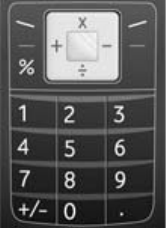
92 Applications
Editing the Alarm Setting
“Applications”
→
“Alarms”
1. Select the desired setting and edit it.
Resetting an Alarm Setting
“Applications”
→
“Alarms”
1. Select the alarm you wish to reset.
2. Select “Reset Alarm”.
Resetting All Alarm Settings
“Applications”
→
“Alarms”
→
“Clear All”
Deactivating or Activating an Alarm
“Applications”
→
“Alarms”
1. Highlight the alarm you wish to deactivate or
activate.
2. Press [Options] and select “Switch Off” or “Switch
On”.
Calculator
The calculator function performs the 4 arithmetic
calculations using up to 11 digits.
“Applications”
→
“Calculator”
The calculator is displayed on the display.
Key operations for calculation are as follows:
To enter a decimal point, press R.
To clear the entered number or operand, press
[Clear].
To do the calculations, press e.
To start a new calculation, press [Clear].
(M 3-3)
Applications 93
Rate Conversion
You can also use the calculator as a currency calculator
to convert from/to a home currency using a conversion
rate that you enter.
To Set a Currency Conversion Rate
“Applications”
→
“Calculator”
→
[Options]
→
“Exchange Rate”
1. Select “Foreign -> Domestic” or “Domestic ->
Foreign”.
2. Enter the currency conversion rate.
To delete all digits, press [Clear].
To Convert a Value
“Applications”
→
“Calculator”
1. Enter the value to be converted.
2. Press [Options] and select “In Domestic” or “In
Foreign”.
The result is displayed.
Note
• You cannot perform step 2 when an arithmetic
symbol (
+
,
−
,
×
or
÷
) is displayed.
Voice Recorder
This allows you to record a voice clip of up to 180
seconds, which can be used to remind you of schedule
entries or be sent within a multimedia message. The
recorded voice clip is registered in Saved Sounds.
Voice clips are saved in “.amr” format.
Recording a Voice Clip
“Applications”
→
“Voice Recorder”
1. Press e to start recording.
To stop recording before the recording time is over,
press e.
2. Select “Save” to save the voice clip.
To play back the recorded voice clip, select
“Playback”.
To record a voice clip again, press [Cancel].
Note
• To change recorded size before recording, press
[Options] and select “Record Size”. Then select
“Extended Voice” or “For Message”.
• When the Message Size described on page 66 is set to
“300 KB”, “Record Size” is not displayed.
(M 3-4)
94 Applications
• The volume varies depending on the Multimedia
Volume settings (p. 106). The sound is deactivated
when “Multimedia Volume” is set to “Silent”. To
adjust the volume, press a (or d/the side-up key)
or b (or c/the side-down key).
Sending Voice Clips
“Applications”
→
“Voice Recorder”
1. Press e to start recording.
2. Press e to stop recording.
3. Select “Save and Send”.
For details on creating a message, see “Creating a New
MMS” on page 62.
Note
• “Save and Send” is not displayed after recording in
extended voice mode.
Phone Help
You can view the help list and use it to guide you in the
phone’s functions.
“Applications”
→
“Phone Help”
1. Press a or b.
(M 3-5)

Calendar 95
Calendar
The calendar allows you to easily schedule
appointments.
These entries can also be sent via Bluetooth wireless
technology to a PC to share the same schedules.
Creating a New Entry
“Calendar”
1. Highlight the desired day to which you want to add
an event.
2. Press [Options] and select “Add New Entry”.
3. Enter the subject.
4. Enter the location.
5. Select the desired category.
6. Enter the start date.
7. Enter the start time.
8. Select the desired duration.
9. Select the desired reminder option.
Note
• The reminder function sounds even if the phone is
switched off.
• The reminder will not sound when “Ringer Volume”
(p. 102) is set to “Silent”.
• When selecting “Other” in step 8, you can enter the
desired end date and time.
• When selecting “Other” in step 9, you can enter the
desired date and time.
• On the date entry screen when entering “Start Date”
in step 6 or choosing “Other” in steps 8 and 9 and so
on, press [Options] and select “Refer to Calendar”
to make it easier to find the desired date from the
monthly calendar that is displayed.
(M 7)
96 Calendar
Editing the Reminder Tone
“Calendar”
1. Select the day including schedule entries the
reminder tone of which you wish to edit.
2. Highlight the desired entry.
3. Press [Options] and select “Edit”.
4. Select the reminder field and select the desired
option.
If you select “No Reminder”, the reminder is turned
off.
5. Select “Tone” and select “Preset Sounds” or “My
Sounds”.
6. Select the desired tone.
For details on selecting a tone, see “Assigning
Ringtone” on page 103.
7. Select “Vibration” and select from “On” or “Off”.
For details on selecting a vibration, see “Vibration”
on page 103.
8. Select “Duration” and enter the desired time.
9. Press [OK].
10.Press [Save].
Sending a Schedule Entry
“Calendar”
1. Select the day including schedule entries you wish
to send.
2. Highlight the desired entry you wish to send.
3. Press [Options] and select “Send”.
4. Select “Via Bluetooth”.
For “Via Bluetooth”
The phone starts searching for Bluetooth wireless
technology enabled devices within 10 metres.
When detected, a list of enabled devices is displayed
allowing you to select the desired device. The
connection can be established and the entry is sent.
Note
• When pairing, you need to enter your passcode when
establishing contact with a Bluetooth wireless
technology enabled device for the first time except
when “Authentication” (p. 100) is set to “Off”.
Calendar 97
Receiving a Schedule Entry
When the phone receives a schedule entry, a
confirmation message appears.
1. Press [Yes].
The received entry is registered in the Calendar.
Press [No] to reject.
Tip
• For details on making Bluetooth wireless settings,
see “Connectivity” on page 98.
Viewing an Entry
“Calendar”
1. Select the day including schedule entries you wish
to view.
The list of entries is displayed.
2. Select the desired entry.
Press d to switch entries, if available, in the
selected day.
To Search By Date
1. In the monthly or daily view, press [Options].
2. Select “Go to”.
3. Select “Today” to display today or “Enter date” to
enter the desired date.
To Search By Subject
1. In the monthly or daily view, press [Options].
2. Select “Find”.
3. Enter the desired text.
To Change the Week Format
1. In the monthly view, press [Options].
2. Select “Week Format”.
3. Select “Monday-Sunday” or “Sunday-Saturday”.
Deleting Entries
1. In the monthly or daily view, press [Options].
2. Select “Delete”.
3. Select the desired option.
• “This Entry” (daily view only):
Deletes the selected entry.
• “All this Day”: Deletes all entries for the selected
day.
• “All this Month”: Deletes all entries for the selected
month.
• “Up to Last Month”:
Deletes all entries before this
month.
• “All Entries”: Deletes all entries in this
application.

98 Settings
Settings
Connectivity
By configuring the settings in this menu, you can
connect to Bluetooth wireless technology enabled
phones, as well as PCs (USB connection is possible
using the optional Data Cable accessory).
Using the Bluetooth Wireless Function
To Turn On or Off
“Settings”
→
“Connectivity”
→
“Bluetooth”
→
“Switch On/Off”
1. Select “On” or “Off”.
When you select “On”, the Bluetooth wireless
setting is activated and “ ” is displayed.
Tip
• You can turn the Bluetooth wireless function on or off
by pressing e, then R during standby.
To Search for Devices to be Paired
For using the Bluetooth wireless function, you need to
search for other Bluetooth wireless technology enabled
devices to establish contact with your phone. Keep your
phone within a distance of 10 metres from the devices
before searching.
“Settings”
→
“Connectivity”
→
“Bluetooth”
1. Select “Search for Devices”.
The phone starts searching for devices within 10
metres.
2. Select the desired device for pairing.
3. Enter the device passcode.
Note
• Pairing means “Authentication”.
• The users of two devices with Bluetooth wireless
technology should agree on the same passcode for
both devices in order to pair them.
• The passcode is used just once, there is no need to
remember it. The passcode can be different each time
the devices are connected.
(M 9)
(M 9-1)
(M 9-1-1)
Settings 99
• Devices that do not have a user interface have a
factory-set passcode (i.e. headsets and car kits - see
the device user guide).
• If the Bluetooth wireless function is off before
searching, the phone turns the Bluetooth wireless
function on automatically and starts searching.
• When you wish to perform the device search again,
the device list where all devices searched will be
displayed when selecting “Search for Devices”
again in step 1. Highlighting “New Devices” at the
top of the list and pressing e will resume the new
search and refresh the list.
• You can only select one device for pairing. To change
the paired device, see “Handsfree Devices” on this
page.
Handsfree Devices
You can activate, rename, and delete the paired
handsfree device in the list.
To Activate a Device
“Settings”
→
“Connectivity”
→
“Bluetooth”
→
“Handsfree Devices”
1. Select the device you wish to activate.
Tip
• You can save battery power by turning the Bluetooth
wireless function off whilst it is not in use. Turn the
Bluetooth wireless function off in “To Turn On or
Off” on page 98 or in “To Turn Off Automatically”
on page 100.
• During a call, you can divert voice call to the paired
device. Press [Options] and select “Enable
Bluetooth”. If you wish to disconnect the paired
device, select “Disable Bluetooth”.
To Rename a Device
“Settings”
→
“Connectivity”
→
“Bluetooth”
→
“Handsfree Devices”
1. Highlight the device you wish to rename.
2. Press [Options] and select “Change Name”.
3. Rename the device.
100 Settings
To Clear a Device Name
“Settings”
→
“Connectivity”
→
“Bluetooth”
→
“Handsfree Devices”
1. Highlight the device you wish to clear.
2. Press [Options] and select “Delete”.
Paired Devices
You can rename and delete the paired device in the list.
Bluetooth Wireless Settings
With this setting you can rename your phone, prevent
other devices from recognising your phone and turn the
Bluetooth wireless function off automatically to save
battery power, etc.
To Rename Your Phone
You can rename your phone. The name is shown on
other devices when your phone is detected.
“Settings”
→
“Connectivity”
→
“Bluetooth”
→
“Bluetooth Settings”
→
“Device Name”
1. Enter the new device name.
To Show or Hide Your Phone
“Settings”
→
“Connectivity”
→
“Bluetooth”
→
“Visibility”
1. Select the desired visibility settings.
“Show My Phone”: Allows other devices to
recognize your phone.
“Hide My Phone”: Hides your phone from other
devices.
To Turn Off Automatically
“Settings”
→
“Connectivity”
→
“Bluetooth”
→
“Bluetooth Settings”
→
“Bluetooth Time Out”
1. Select the desired time.
Your phone turns the function off automatically in
the specified time.
To Turn the Authentication Request On or Off
You can request the sender or receiver of the data to
authenticate the passcode (exchanging the passcode)
before pairing devices.
“Settings”
→
“Connectivity”
→
“Bluetooth”
→
“Bluetooth Settings”
→
“Authentication”
1. Select “On” or “Off”.
Settings 101
Note
• No authentication is required for the paired devices.
• Even if you select “Off”, you may authenticate the
passcode when the sender requests it.
PC Software
By connecting your phone to a PC, you can transmit
pictures, sounds, video clips, Contacts List entries, and
schedule entries. Follow the procedure to select the
connection method (Bluetooth wireless or USB). For
details on getting the link software, see page 125.
“Settings”
→
“Connectivity”
→
“PC Software”
1. Select the desired connection type from “Data
Cable” or “Bluetooth”.
Profiles
Tone sound and vibration set can be customised for
each profile according to your environment.
There are 6 profiles: Normal, Meeting, Activity, Car,
Headset and Silent.
Activating a Profile
“Settings”
→
“Profiles”
1. Select the desired profile.
Note
• When a profile is set, the corresponding icon
described on page 30 is displayed on the standby
screen.
Tip
• Press and hold R to switch Profiles settings
between Normal and Silent mode during standby.
(M 9-1-2)
(M 9-2)
102 Settings
Customising Profiles
“Settings”
→
“Profiles”
1. Highlight the profile you wish to customise.
2. Press [Options] and select “Personalise”.
3. Select the setting you wish to customise and change
as desired.
For details about settings, see pages 102 to 107.
4. Press [Save] when finished.
Resetting Profile Settings
“Settings”
→
“Profiles”
1. Highlight the profile you wish to reset.
2. Press [Options] and select “Set to Default”.
3. Enter your handset code.
The default handset code is “0000”. For details on
changing the handset code, see “To Change Handset
Code” on page 122.
Ringer Volume
You can adjust the ringer volume to one of 6 levels or a
step tone.
“Settings”
→
“Profiles”
1. Highlight the profile you wish to customise.
2. Press [Options] and select “Personalise”.
3. Select “Ringer Volume”.
The current volume level is displayed.
4. Press a (or d) to increase the ringer volume or
press b (or c) to decrease the ringer volume and
then press e.
To select “Step Tone”, press a (or d) at level 5.
To select “Silent”, press b (or c) at level 1.

Settings 103
Assigning Ringtone
You can select the ringtone from 23 tones including 5
patterns, 3 alerts, 10 sound effects and 5 melodies. You
can also select a sound in Saved Sounds as the default
ringtone excluding the AMR or WAVE format.
“Settings”
→
“Profiles”
1. Highlight the profile you wish to customise.
2. Press [Options] and select “Personalise”.
3. Select “Assign Ringtone”.
4. Select “Preset Sounds” or “My Sounds”.
5. Select the ringtone you wish to use.
To hear the demo play, press e. To stop playing,
press e again.
6. Press [Options] and select “Assign”.
Note
• If you delete a ringtone that uses a sound in Saved
Sounds, the default ringtone is set.
Vibration
When the vibrator option is set on, the phone will
vibrate for incoming calls regardless of the ringer
volume and tone settings.
“Settings”
→
“Profiles”
1. Highlight the profile you wish to customise.
2. Press [Options] and select “Personalise”.
3. Select “Vibration”.
4. Select from “On” or “Off”.
Tip
• When you select “On” in step 4, “ ” is displayed
on the standby screen.
Alerts
You can personalise profiles for alerts including
warning tone, message alert and low battery alert.
104 Settings
Warning Tone
Your phone emits the warning tone when an error
occurs.
“Settings”
→
“Profiles”
1. Highlight the profile you wish to customise.
2. Press [Options] and select “Personalise”.
3. Select “Alerts”.
4. Select “Warning Tone”.
5. Select “Switch On/Off”.
6. Select “On” or “Off”.
7. Select “Volume” and select from “High”, “Middle”
or “Low”.
8. Select “Tone” and select “Preset Sounds” or “My
Sounds”.
9. Select the desired tone.
For details on selecting a tone, see “Assigning
Ringtone” on page 103.
10.Select “Duration” and select the desired time.
Message Alert
When receiving messages, special ringtones can be set.
“Settings”
→
“Profiles”
1. Highlight the profile you wish to customise.
2. Press [Options] and select “Personalise”.
3. Select “Alerts”.
4. Select “Message Alert”.
5. Select from “Multimedia”, “Text” or “WAP”.
6. Select “Volume” and select the desired volume.
7. Select “Sound” and select “Preset Sounds” or “My
Sounds”.
8. Select the desired ringtone.
For details on selecting a ringtone, see “Assigning
Ringtone” on page 103.
9. Select “Vibration” and select from “On” or “Off”.
For details on selecting a vibration, see “Vibration”
on page 103.
10.Select “Duration” and enter the desired time.
Settings 105
Low Battery Alert
Adjust the volume of the alert when the battery
becomes low.
“Settings”
→
“Profiles”
1. Highlight the profile you wish to customise.
2. Press [Options] and select “Personalise”.
3. Select “Alerts”.
4. Select “Low Battery Alert”.
5. Select from “High”, “Low” or “Silent”.
Keypad Tones
When the keypad tone is set on, you will hear a
confirmation tone each time you press any keys.
“Settings”
→
“Profiles”
1. Highlight the profile you wish to customise.
2. Press [Options] and select “Personalise”.
3. Select “Keypad Tones”.
4. Select “Switch On/Off”.
5. Select “On” or “Off”.
6. Select “Volume” and select from “High”, “Middle”
or “Low”.
7. Select “Tone” and select from “Preset Sounds”,
“My Sounds” or “Default Tone”.
When selecting “Default Tone”, go to step 9.
8. Select the desired tone.
For details on selecting the tone, see “Assigning
Ringtone” on page 103.
9. Select “Duration” and select the desired time.
106 Settings
Multimedia Volume
You can adjust volume for Video Camera, Voice
Recorder, My Items, browser and multimedia
messages.
“Settings”
→
“Profiles”
1. Highlight the profile you wish to customise.
2. Press [Options] and select “Personalise”.
3. Select “Multimedia Volume”.
The current volume level is displayed.
4. Press a (or d) to increase the volume or press b
(or c) to decrease the volume and then press e.
To select “Silent”, press b (or c) at level 1.
Power On Sound/Power Off Sound
The phone can be set to emit a sound when it is
switched on or off. You can define the volume, duration
and the melody to be used for this task.
“Settings”
→
“Profiles”
1. Highlight the profile you wish to customise.
2. Press [Options] and select “Personalise”.
3. Select “Power On Sound” or “Power Off Sound”.
4. Select “Switch On/Off”.
5. Select “On” or “Off”.
6. Select “Volume” and select the desired volume.
7. Select “Sound” and select “Preset Sounds” or “My
Sounds”.
8. Select the desired sound.
For details on selecting a sound, see “Assigning
Ringtone” on page 103.
9. Select “Duration” and enter the desired time.
Settings 107
Echo Cancel
This function is for cancelling irritating echoes,
especially when using the handsfree car kit.
“Settings”
→
“Profiles”
1. Highlight the profile you wish to customise.
2. Press [Options] and select “Personalise”.
3. Select “Echo Cancel”.
4. Select “On” or “Off”.
Any Key Answer
You can also answer a call by pressing any key except
F or [Busy]. For details, see page 34.
“Settings”
→
“Profiles”
1. Highlight the profile you wish to customise.
2. Press [Options] and select “Personalise”.
3. Select “Any Key Answer”.
4. Select “On” or “Off”.
Auto Answer (for handsfree car kit only)
Auto Answer function allows you to answer calls
automatically by connecting the handsfree car kit for
Bluetooth to your phone via Bluetooth wireless
technology.
You can select the desired time until your phone
answers.
“Settings”
→
“Profiles”
1. Highlight “Car”.
2. Press [Options] and select “Personalise”.
3. Select “Auto Answer”.
4. Select the desired time.
Select “Off” to disable it.
108 Settings
Setting the Display
You can change the settings of the screen.
Setting the Main Display
To Set the Wallpaper
For the standby screen, 3 pictures are provided.
Pictures taken with the digital camera or images
downloaded from a WAP site can be used for
wallpapers.
To Set My Pictures
“Settings”
→
“Display”
→
“Main Display”
→
“Wallpaper”
→
“My Pictures”
1. Select the desired picture.
2. After displaying the picture, press e.
3. Specify the area you wish to display using the
navigation keys.
Note
• Some pictures cannot be used because of their
picture and data types.
• When using a file in the Animation GIF format, turn
the “Standby Calendar” option off.
To Display Monthly Calendar
You can display the monthly calendar during standby.
“Settings”
→
“Display”
→
“Main Display”
→
“Standby Calendar”
1. Select “One Month”.
Select “Off” to turn it off.
Note
• If you select “One Month” when using the file in the
Animation GIF format for the wallpaper, the
wallpaper setting is reset to default. When using the
file in the Animation GIF format, select “Off”.
Tip
• The weekly format of the monthly calendar depends
on the setting of “Week Format” (p. 97).
To Assign the Pictures
Pictures can be displayed when turning the power on or
off, when receiving an incoming call, or when
operating the alarm.
Pictures taken by a digital camera or images
downloaded from a WAP site can be used.
(M 9-3)
(M 9-3-1)
Settings 109
To Set Built-in Pictures
“Settings”
→
“Display”
→
“Main Display”
→
“Graphics”
1. Select the desired situation to set the picture.
2. Select “Preset Animation” when you select “Power
On” or “Power Off” in step 1.
Select “Pattern 1”, “Pattern 2” or “Pattern 3” when
you select “Incoming Call” or “Alarm” in step 1.
To Set My Pictures
“Settings”
→
“Display”
→
“Main Display”
→
“Graphics”
1. Select the desired situation to set the picture.
2. Select “My Pictures”.
3. Select the desired picture.
4. After displaying the picture, press e.
5. Specify the area you wish to display using the
navigation keys.
Note
• Some pictures cannot be used because of their
picture and data types.
To Set the Greeting Message
You can set the message which will appear when the
phone is turned on.
“Settings”
→
“Display”
→
“Main Display”
→
“Greeting Message”
1. Select “Switch On/Off”.
2. Select “On” or “Off”.
3. Select “Edit Message” and enter the message.
Up to 16 characters can be stored as a message.
For details on entering characters, see “Entering
Characters” on page 39.
To Show the Clock
You can display the current date and/or time on the
standby screen.
“Settings”
→
“Display”
→
“Main Display”
→
“Show
Clock”
1. Select from “Time Only”, “Date & Time” or “Off”.
110 Settings
To Set the Backlight
You can turn the backlight of the screen on or off when
you press the keypad or the optional cigarette lighter
charger is connected to the phone.
You can change time the backlight is on for, which will
help conserve battery life.
Tip
• When you purchase this phone, Backlight is set to 15
seconds.
To Select the Backlight Time Out
“Settings”
→
“Display”
→
“Main Display”
→
“Backlight”
→
“Time Out”
1. Select the desired time.
Select “Off” to turn it off.
To Turn On/Off the Backlight whilst Charging with
the Cigarette Lighter Charger
With this setting On, the phone’s backlight is on when
the Cigarette Lighter Charger is connected.
“Settings”
→
“Display”
→
“Main Display”
→
“Backlight”
→
“In Car”
1. Select “On” or “Off”.
To Adjust the Brightness of the Backlight
You can adjust the brightness of the backlight of the
screen from 4 levels.
“Settings”
→
“Display”
→
“Main Display”
→
“Backlight”
→
“Brightness”
1. Adjust the brightness by pressing a (Light) and
b (Dark) for maximum clarity.
2. Press e.
To Set the Display Saving
This phone’s screen will automatically turn off.
You can change the time before the Display Saving will
go into effect, which will help conserve battery life.
Tip
• When you purchase this phone, Display Saving is set
to 10 minutes.
“Settings”
→
“Display”
→
“Main Display”
→
“Display Saving”
1. Select the desired time.
Settings 111
Note
• Display Saving does not work whilst you are calling,
using WAP, or using an application.
• To cancel the Display Saving: The display saving
continues until either a key is pressed or there is an
incoming alert. The first key press only cancels this
function. You must press another key in order to input
any numerical or text value.
Setting the External Display
To Select the Backlight Time Out
You can select the backlight time out for the external
display.
“Settings”
→
“Display”
→
“External Display”
→
“Backlight”
1. Select the desired time.
Select “Off” to turn it off.
To Adjust the Contrast
You can adjust the LCD contrast of the external display
between 9 levels.
“Settings”
→
“Display”
→
“External Display”
→
“LCD Contrast”
1. Adjust the contrast by pressing a (High) and b
(Low) for maximum clarity.
2. Press e.
Display Setting Reset
The display settings can be reset to their default settings.
“Settings”
→
“Display”
→
“Set to Default”
1. Enter your handset code.
The default handset code is “0000”. For details on
changing the handset code, see “To Change Handset
Code” on page 122.
Sound
You can use this menu to check or edit the current
Profiles settings.
Call Settings
Set various types of functions and services.
Diverts
This service is used to divert incoming calls to your
voice mail system or to another number depending on
certain conditions in which you cannot answer a call.
(M 9-3-2)
(M 9-3-3)
(M 9-4)
(M 9-5)
(M 9-5-1)

112 Settings
To Divert Calls
“Settings”
→
“Call Settings”
→
“Diverts”
1. Select one of the following options.
• “All Calls”: Diverts all voice calls without
ringing.
• “When Busy”: Diverts incoming calls when you
are on a call.
• “No Answer”: Diverts incoming calls if you do
not answer a call within a certain
period of time.
• “Not Reachable”: Diverts incoming calls when your
phone is out of network service or
switched off.
2. Select “On”.
3. Select the desired Contacts List entry including a
phone number you wish to divert.
If the desired entry does not exist, select “Enter
Number” and enter the phone number.
4. Press e.
If you select “No Answer” in step 1:
5. Select the period of time from 6 levels (05 to 30
seconds).
Note
• When a divert is set to “All Calls”, “ ” is displayed
on the standby screen.
Tip
• If you select “By Service” in step 2, you can select
further divert options.
To Check the Divert Status
“Settings”
→
“Call Settings”
→
“Diverts”
1. Select the divert option you wish to check.
2. Select “Status”.
You can check the status of the selected divert
option.
Call Waiting
If you wish to be able to receive another incoming call
whilst you have a call in progress, you must activate the
Call Waiting service.
“Settings”
→
“Call Settings”
→
“Call Waiting”
1. Select “On” or “Off”.
Note
• The Call Waiting service may not be available on all
mobile phone networks. Contact your network
operator for more information.
(M 9-5-2)
Settings 113
Showing Your Phone Number
This lets you control whether to show your phone
number when calling another party or not.
“Settings”
→
“Call Settings”
→
“Show Your
Number”
1. Select “On” or “Off”.
Note
• Some networks do not support this service. Please
check with your service provider for availability.
Restrict Calls
This function lets you place restrictions on incoming
and outgoing calls. To activate this option you will need
the specified password, which is available from your
service provider.
“Settings”
→
“Call Settings”
→
“Restrict Calls”
1. Select from “Outgoing Calls” or “Incoming Calls”.
• Outgoing Calls: Restricts outgoing calls.
• Incoming Calls: Restricts incoming calls.
2. Select one of the following options.
(For “Outgoing Calls”)
• Bar Foreign Calls: Restricts all outgoing
international calls.
• Bar All Outgoing Calls:
Restricts all outgoing calls
except emergency calls.
• Only Local & Home: Restricts all outgoing
international calls except to
your home country.
(For “Incoming Calls”)
• Bar All Incoming Calls:
Restricts all incoming calls.
• Bar if Abroad: Restricts all incoming calls
when you are outside of the
coverage from your
registered network operator.
3. Select one of the following options.
• “All Services”: Restricts all services.
• “Voice Calls”: Restricts all voice calls.
• “Data”: Restricts all data calls.
• “Fax”: Restricts all fax calls.
• “Messages”: Restricts all messages.
• “All except msgs”: Restricts all services except
messages.
4. Select “On” or “Off”.
5. Enter the network password.
(M 9-5-3)
(M 9-5-4)
114 Settings
To Cancel Settings
“Settings”
→
“Call Settings”
→
“Restrict Calls”
1. Select “Outgoing Calls” or “Incoming Calls”.
2. Select “Cancel All”.
3. Enter the network password.
Fixed Dialling No.
This option is available on most SIM cards of GSM
mobile phones. It allows you to configure a SIM card so
that it can only be used to make calls to the numbers of
a predefined list.
Note
• The Fixed Dialling No. is not available with some
service providers or SIM cards. Please contact your
service provider for more information.
To Enable Fixed Dialling No.
“Settings”
→
“Call Settings”
→
“Restrict Calls”
→
“Fixed Dialling No.”
1. Enter your PIN2 code.
Pin2 is a second PIN code used to unlock certain
features of a SIM card, such as Fixed Dialling and
Call Cost metering. Not all SIM cards use the PIN2
code.
2. Select “Switch On/Off”.
3. Select “On” or “Off”.
To Add a New Name
“Settings”
→
“Call Settings”
→
“Restrict Calls”
→
“Fixed Dialling No.”
1. Enter your PIN2 code.
2. Select “Edit Dial List”.
3. Select “Add New Contact”.
4. Add a name and a phone number.
For details on adding a name and a phone number,
see “Add New Contact” on page 44.
5. Press [Save].
Settings 115
Changing the Network Password
“Settings”
→
“Call Settings”
→
“Restrict Calls”
→
“Change Password”
1. Enter the old network password.
2. Enter a new network password.
3. Enter a new network password again.
If you enter the incorrect password, you are asked to
enter the password again.
4. Press e.
Auto Redial (M 9-5-5)
See “Automatic Redialling” on page 34.
Minute Minder (M 9-5-6)
Minute Minder function informs you of your talk time
by sounding a tone after every minute.
“Settings”
→
“Call Settings”
→
“Minute Minder”
1. Select “On” or “Off”.
Call Setting Reset
The call settings can be reset to their default settings.
“Settings”
→
“Call Settings”
→
“Set to Default”
1. Enter your handset code.
The default handset code is “0000”. For details on
changing the handset code, see “To Change Handset
Code” on page 122.
(M 9-5-7)
116 Settings
Date & Time
You need to set the correct time and date in order for
your phone’s various time-based functions to work
correctly.
“Settings”
→
“Date & Time”
→
“Set Date/Time”
1. Enter the day, month, year and time using the digit
keys.
Tip
• When you enter the time in the 12-hour format, press
P to switch between am and pm. The order in
which the date and time is displayed is based on the
format setting.
Selecting the Time Format
“Settings”
→
“Date & Time”
→
“Time Format”
1. Select “12 hour” or “24 hour”.
Selecting the Date Format
“Settings”
→
“Date & Time”
→
“Date Format”
1. Select from “D.M.Y”, “M-D-Y”, or “Y/M/D”.
Setting the Daylight Saving
“Settings”
→
“Date & Time”
→
“Daylight Saving”
1. Select “On” or “Off”.
Setting the Time Zone
“Settings”
→
“Date & Time”
→
“Time Zone”
→
“Change Zone”
1. Press c or d to select the home city to set.
Customising the Time Zone
“Settings”
→
“Date & Time”
→
“Time Zone”
→
“Set
Custom Zone”
1. Enter the time-zone differences using the digit keys.
Pressing P switches between – and +.
(M 9-6)
Settings 117
Changing the Language
You can change the language that the phone uses to
display messages.
“Settings”
→
“Language”
1. Select the desired language.
Tip
• You can also change the input language on the text
entry screen (p. 39).
Note
• If you select “Automatic” in step 1, the language
preset on the SIM card is selected.
• If the language preset on the SIM card is not
supported, then the default language of the phone is
selected.
Network
Network Settings
To Select a Network Automatically
Each time the power is turned on, your phone always
tries to connect to the preferred network.
If your phone is not connected to the network, you can
perform the following immediately to establish the
preferred network connection.
“Settings”
→
“Network”
→
“Select Network”
→
“Automatic”
To Set the Network Manually
“Settings”
→
“Network”
→
“Select Network”
→
“Manual”
1. Select the desired network.
(M 9-7) (M 9-8)
(M 9-8-1)
118 Settings
To Add a New Network
“Settings”
→
“Network”
→
“Select Network”
→
“Add New Network”
If there is no entry, press e and go to step 2.
If there is an entry, press e and perform the following
steps.
1. Select “Add”.
2. Enter the country code.
3. Enter the network code.
4. Enter a new network name.
To Change the Position of a Network in the
Preferred List
“Settings”
→
“Network”
→
“Select Network”
→
“Set
Preferred”
1. Select the name of the network to change the
position in the list.
2. Select “Insert” or “Add to end”.
To Delete a Network from the Preferred List
“Settings”
→
“Network”
→
“Select Network”
→
“Set
Preferred”
1. Select the name of the network you wish to delete.
2. Select “Delete”.
WAP/MMS/Email Settings
Note
• For normal operations, you do not need to change
the WAP/MMS settings.
Settings 119
WAP Settings (*: Item to be set as mandatory)
“Profile Name”*: WAP profile name (Unique name)
“IP Address”*: IP address for WAP
“Homepage”: Homepage
“Port Number”*: Security option (1-65535)
“Primary DNS”: Primary DNS
“Secondary DNS”: Secondary DNS
“Circuit Prompt”: Circuit prompt (“Enable” or
“Disable”)
“Connection Type”:
Bearer connection type (“GPRS
Then CSD”, “GPRS” or “CSD”)
“Username”: User name
“Password”: Password
“GPRS Settings”:
“APN”*: Access point name
“Username”: User name
“Password”: Password
“CSD Settings”:
“Phone No.”*: Access point number
“Line Type”: Line type (“ISDN” or “Analogue”)
“Username”: User name
“Password”: Password
MMS Settings (*: Item to be set as mandatory)
“Profile Name”*: MMS profile name (Unique name)
“IP Address”*: IP address for MMS
“Relay Server URL”*:
MMS relay server
“Port Number”*: Security option (1-65535)
“Primary DNS”: Primary DNS
“Secondary DNS”: Secondary DNS
“Connection Type”:Bearer connection type (“GPRS
Then CSD”, “GPRS” or “CSD”)
“Username”: User name
“Password”: Password
“GPRS Settings”:
“APN”*: Access point name
“Username”: User name
“Password”: Password
“CSD Settings”:
“Phone No.”*: Access point number
“Line Type”: Line type (“ISDN” or “Analogue”)
“Username”: User name
“Password”: Password
120 Settings
Email Settings (*: Item to be set as mandatory)
“Profile Name”*: Email profile name (Unique name)
“Email Address”*: Email address
“Return Address”: Email address to which the Email
message is returned when sending
fails
“POP3 Server”: Server for receiving Email
messages
“
Server Name
”*: Server name
“User ID”*: User ID
“Password”*: Password
“Port Number”
: Security option (1-65535)
“SMTP Server”: Server for sending Email messages
“
Server Name
”*: Server name
“User ID”: User ID
“Password”: Password
“Port Number”
: Security option (1-65535)
“Authentication”
: Authentication (Off, POP before
SMTP, SMTP Authentication)
“Primary DNS”: Primary DNS
“Secondary DNS”: Secondary DNS
“Connection Type”:Bearer connection type (“GPRS
Then CSD”, “GPRS” or “CSD”)
“GPRS Settings”:
“APN”*: Access point name
“Username”: User name
“Password”: Password
“CSD Settings”:
“Phone No.”*: Telephone Number
“Line Type”: Line type (“ISDN” or “Analogue”)
“Username”: User name
“Password”: Password
To Activate the WAP/MMS/Email Profile
“Settings”
→
“Network”
1. Select from “WAP Settings”, “MMS Settings” or
“Email Settings”.
2. Select the desired profile.
Settings 121
To Edit the WAP/MMS/Email Profile
“Settings”
→
“Network”
1. Select from “WAP Settings”, “MMS Settings” or
“Email Settings”.
2. Highlight the desired profile.
3. Press [Options] and select “Edit”.
4. Edit the desired item.
To Copy the WAP/MMS/Email Profile
“Settings”
→
“Network”
1. Select from “WAP Settings”, “MMS Settings” or
“Email Settings”.
2. Highlight the desired profile.
3. Press [Options] and select “Copy”.
4. Edit the new profile name.
To Delete the WAP/MMS/Email Profile
“Settings”
→
“Network”
1. Select from “WAP Settings”, “MMS Settings” or
“Email Settings”.
2. Highlight the desired profile.
3. Press [Options] and select “Delete”.
Security
Enabling/Disabling the PIN Code
If the PIN code is enabled you are asked to enter the
PIN code each time the phone is switched on. Your PIN
code is stored on the SIM card and you should have
been made aware of the code when you purchased the
SIM card. Contact your service provider for further
details.
“Settings”
→
“Security”
→
“PIN Entry”
1. Select “On” to enable the PIN code.
Select “Off” to disable it.
2. Enter your PIN code.
Note
• If you enter the wrong PIN code three times in step 2,
the SIM card will lock. To remove the lock, contact
your service provider/SIM card vendor.
(M 9-9)
(M 9-9-1)
122 Settings
To Change PIN Code
This allows you to change the PIN code stored on the
SIM card. Before you change the PIN code, select “On”
in step 1 in “Enabling/Disabling the PIN Code”.
“Settings”
→
“Security”
→
“PIN Entry”
→
“Change
PIN”
1. Enter the existing PIN code.
2. Enter a new PIN code.
3. Enter the new PIN code again.
Changing PIN2 Code
PIN2 is a second PIN code used to unlock certain
features of a SIM card, such as Fixed Dialling and Call
Cost metering. Not all SIM cards use the PIN2 code.
The following shows you how to change PIN2 code.
“Settings”
→
“Security”
→
“Change PIN2”
1. Enter the existing PIN2 code.
2. Enter a new PIN2 code.
3. Enter the new PIN2 code again.
Handset Lock
The Handset Lock is an additional security feature
which prevents unauthorised use of the phone or certain
features.
“Settings”
→
“Security”
→
“Handset Lock”
1. Select “On” or “Off”.
2. Enter your handset code.
To Change Handset Code
Before you change the handset code, select “On” in step
1 in “Handset Lock”. The default handset code is
“0000”.
“Settings”
→
“Security”
→
“Handset Lock”
→
“Change Code”
1. Enter the old handset code.
2. Enter a new handset code.
3. Enter the new handset code again.
Master Reset
All settings can be reset to their default settings.
“Settings”
→
“Master Reset”
1. Enter your handset code.
(M 9-9-2)
(M 9-9-3)
(M 9-0)

Connecting GX33 to Your PC 123
Connecting GX33 to Your PC
You can use the following functions by connecting the
GX33 to your PC using an USB port* or Bluetooth
wireless technology port:
• GSM/GPRS modem
• Handset Manager for GX33
* Requires an optional USB Data Cable XN-1DC30 for
USB port connection.
System Requirements
Operating System:
Windows® 2000*, Windows® XP**, Windows
Vista
* Service Pack 4
** Service Pack 1a or later
Supported Software:
Microsoft® Outlook
Interface:
USB port or Bluetooth wireless port
CD-ROM drive
GSM/GPRS Modem
You can use GX33 as a GSM/GPRS modem to access
the Internet from your PC. Connect your phone to your
PC via Bluetooth wireless technology or USB interface.
Software installation on your PC is required.
Modem via the USB Data Cable
1. Insert the supplied CD-ROM into your PC’s
CD-ROM drive.
The GX33 CD-ROM screen is displayed.
If the GX33 CD-ROM screen is not displayed,
double-click [Launcher.exe] in your CD-ROM.
2. Select the USB driver from the on-screen
instructions of your CD-ROM, and start installation
of USB driver software following the on-screen
instructions of your CD-ROM.
•Yo
u can also download USB driver software from
our web-site, http://www.sharp-mobile.com.
•
During installation, the on-screen instructions ask
you to connect your phone to your PC. Power on
your phone and atta
ch the phone to the USB port
of your PC using the USB Data Cable (Optional
Accessory).

124 Connecting GX33 to Your PC
3. Follow the on-screen instructions to complete
installation.
4. Select the modem driver from the on-screen
instructions of your CD-ROM, and install modem
driver software following the on-screen instructions
of your CD-ROM.
•
You can also download modem driver software
from our web-site, http://www.sharp-mobile.com.
5. Follow the on-screen instructions to use your phone
as a modem driver.
• When the on-screen instructions ask modem
driver type, select the cable as a modem driver.
Modem via Bluetooth Connection
1. Turn on the Bluetooth connectivity of your phone.
For how to turn on the Bluetooth connectivity, see
page 98.
2. Pair your PC with your phone.
For how to pair your PC with your phone, see
page 98.
3. Insert the supplied CD-ROM into your PC’s
CD-ROM drive.
The GX33 CD-ROM screen is displayed.
If the GX33 CD-ROM screen is not displayed,
double-click [Launcher.exe] in your CD-ROM.
4. Select the modem driver from the on-screen
instructions of your CD-ROM, and install modem
driver software following the on-screen instructions
of your CD-ROM.
5. Follow the on-screen instructions to use your phone
as a modem driver.
• When the on-screen instructions ask modem
driver type, select Bluetooth as a modem driver.
Note
• Modem communication is not possible whilst
communicating with the Handset Manager via
Bluetooth wireless technology or USB interface.
• It is not recommended that you make or answer calls
when you are using GX33 as a GSM/GPRS modem.
The operation may be interrupted.

Connecting GX33 to Your PC 125
Handset Manager
You can transmit the following items between your
phone and your PC, and can use Contacts List entries on
your PC.
• My Items files (pictures/sounds/video clips)
• Contacts List entries
• Short messages
• Schedule entries
Via USB Data Cable
1. Insert the supplied CD-ROM into your PC’s
CD-ROM drive.
The GX33 CD-ROM screen is displayed.
If the GX33 CD-ROM screen is not displayed,
double-click [Launcher.exe] in your CD-ROM.
2. Select Handset Manager from the on-screen
instructions of your CD-ROM, and start installation
of Handset Manager software following the
on-screen instructions of your CD-ROM.
•
You can also download Handset Manager software
from our web-site, http://www.sharp-mobile.com.
•
If you have not installed the USB driver, follow
steps 2 and 3 on page 123.
3. Follow the on-screen instructions to complete
installation.
•
During installation, the on-screen instructions ask
you to select an interface. Select the USB Data
Cable as an interface.
4. Connect your phone to your PC. Power on your
phone and attach the phone to the USB port of your
PC using the USB Data Cable (Optional
Accessory).
5. Turn on the PC software connectivity of your
phone.
For how to turn on the PC software connectivity, see
page 101.
6. Launch Handset Manager from the relevant folder.
7. Follow the on-screen instructions of Handset
Manager.
For details, see the User Guide Software which was
installed with Handset Manager.

126 Connecting GX33 to Your PC
Via Bluetooth
1. Insert the supplied CD-ROM into your PC’s
CD-ROM drive.
The GX33 CD-ROM screen is displayed.
If the GX33 CD-ROM screen is not displayed,
double-click [Launcher.exe] in your CD-ROM.
2. Select Handset Manager from the on-screen
instructions of your CD-ROM, and start installation
of Handset Manager software following the
on-screen instructions of your CD-ROM.
•
You can also download Handset Manager software
from our web-site, http://www.sharp-mobile.com.
3. Follow the on-screen instructions to complete
installation.
•
During installation, the on-screen instructions ask
you to select an interface. Select
Bluetooth
as an
interface.
4. Turn on the PC software connectivity of your
phone.
For how to turn on the PC software connectivity, see
page 101.
5. Launch Handset Manager from the relevant folder.
6. Follow the on-screen instructions of Handset
Manager.
For details, see the User Guide Software which was
installed with Handset Manager.
Note
• Some large files may not be able to be transmitted
from the PC to the phone.
• Applications (Camera, My Items, etc.) do not run
when the phone is connected to the PC via Bluetooth
wireless technology interface or USB Data Cable.
• If you have already installed Sharp Handset
Manager, you need to uninstall the previous one.
• If you have trouble with installation, uninstall
Handset Manager, restart your PC, reinstall Handset
Manager and restart.
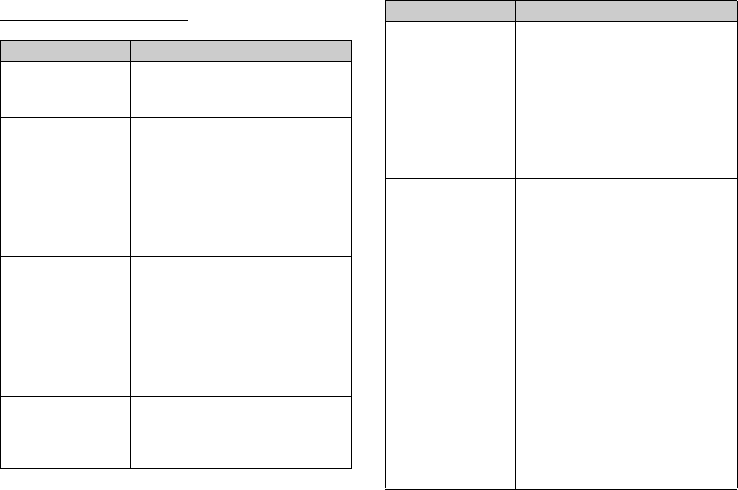
Troubleshooting 127
Troubleshooting
Problem Solution
The phone does not
turn on.
• Make sure the battery is
properly inserted and
charged.
PIN code or PIN2
code is rejected.
•
Make sure you have entered
the correct code (4 to 8 digits).
•
Your SIM card/protected
functions will become locked
after 3 unsuccessful attempts.
• Contact your SIM provider if
you do not have the correct
PIN code.
The SIM card
becomes locked.
• Enter PUK code (8 digits)
provided by your service
provider (if supported).
• If the attempt is successful,
enter the new PIN code and
confirm your phone is
operational again. Otherwise
contact your dealer.
The display is
difficult to read.
•
Adjust the backlight
brightness for the display, and
adjust the LCD contrast for the
external display.
Phone functions do
not work after the
phone is turned on.
• Check the radio signal
strength indicator as you may
be outside the service area.
• Check to see if any error
message is displayed when
you turn your phone on. If so,
contact your dealer.
• Make sure the SIM card is
correctly inserted.
Calls cannot be
made or received.
• If the message “SIM card
error” is displayed at start-up,
you cannot use your SIM card
or the SIM card is damaged.
Contact your dealer or
network service provider.
• Check your call barring, fixed
dialling setting, remaining
battery and call forwarding
settings.
•
Check if your phone is currently
performing data communication
using Bluetooth wireless
technology interface or a USB
Data Cable.
• Check the remaining balance
if you are using a pre-paid
SIM card.
Problem Solution

128 Troubleshooting
Call quality is poor.
• Your current location may not
provide good call quality (i.e.,
in a car or train). Move to a
location where radio signal
strength is greater.
Cannot access
network service.
• Check where your account
has been registered and
where the service is
available.
Cannot send or
receive Text
Message.
• Make sure you are correctly
subscribed for the Short
Message Service, that the
network supports this service,
and that the centre number is
set up correctly. If not, contact
your network service
provider.
Cannot connect to
Multimedia
Message service
provider.
• MMS settings and
configuration may be missing
or incorrect or the network
does not support it. Check
your service provider’s
access point number.
Contact your service provider
to confirm the correct
settings.
Problem Solution
Limited memory
available.
• Delete any unnecessary data.
Call is terminated
unexpectedly.
• Magnetised objects such as
health necklaces placed near
the phone may terminate the
call. Keep your phone away
from such objects.
No entries are
displayed in the
Contacts List.
• Confirm that the Contacts
Location setting (Handset or
SIM) and View Groups setting
are made correctly.
Fax transmission
failure.
• Before transmitting fax data,
configure your fax software to
use the software flow control.
• Use of the optional data cable
is recommended for
transmitting fax data.
Problem Solution

Troubleshooting 129
Cannot receive
OBEX data.
The OBEX data cannot be
received in the following cases:
• Call incoming, call outgoing,
call in progress
• Java™ application executed
• WAP communication mode
enabled
• When transmitting
multimedia messages
• When transmitting Email
messages
• When searching for Bluetooth
wireless technology enabled
devices and displaying the
device list (M 9-1-1)
• When connecting with
devices by the selected
connection method (M 9-1-2)
Problem Solution
http://www.sharp-mobile.com

130 Index
Index
A
Accessories 21
Alarms 91
B
Battery 25
Bluetooth 98, 100
Bluetooth wireless function 98
Bluetooth wireless settings 100
C
Calculator 92
Calendar 95
Call Costs 53
Call functions 33
Answering 34
Call Waiting 36
Conference Call 37
Earpiece volume 35
Making a call 33
Muting 38
Putting on hold 36
Redialling 34
Speed dialling 33
Call Log 51
Call settings 111
Auto Redial 115
Call Waiting 112
Diverts 111
Minute Minder 115
Resetting 115
Restrict Calls 113
Show Your Number 113
Call Timers 52
Cell Broadcasts 73
Centre key 23, 29
Contacts List 43
Assigning a ringtone 48
Changing the list 43
Changing the name order 44
Copying 45
Creating 44
Deleting 46
Dialling 46
Editing 46
Finding 45
Group Call 47
Memory Status 48
Receiving an entry 49
Selecting the storage memory 43
Sending an entry 49
Viewing groups 46
D
Data Counter 52
Date & Time 116
Display indicators 29
Display language 117
Display settings 108
Backlight 110
Backlight brightness 110
Backlight time out 111
Contrast 111
Display Saving 110
Greeting message 109
Pictures 108
Resetting 111
Showing the clock 109
Wallpaper 108
E
Earpiece volume 35
Email 71
Creating 71
Reading 72
Setting Up 72
Index 131
Storing the Email Address of a
Sender in a Contacts List
72
Emergency calls 33
H
Handset code 122
Handset Lock 122
I
Input languages 39
Input method 40
International calls 33
J
Java™ applications 87
L
Left Soft Key 23
M
Master Reset 122
Memory Status 48, 86
Menu and shortcuts 42
Multimedia messages 62
Confirming arrival of delivery
report 65
Creating 62
Inserting attached data 64
Reading 65
Retrieving 65
Sending with Postcard 67
Setting up 66
Storing the phone number or
Email address of a sender
in the Contacts List 65
Turning the slide show setting
on or off 63
My Numbers (Voice/Data/Fax) 52
N
Navigation keys 23
Network settings 117
P
PC connection 123
PC Software 101
Phone Help 94
Picture files 78
PIN code 121
PIN2 code 122
Power on and off 28
Profiles 101
Activating 101
Alerts 103
Any Key Answer 107
Customising 102
Echo Cancel 107
Keypad Tones 105
Multimedia Volume 106
Power Off Sound 106
Power On Sound 106
Resetting 102
Ringer volume 102
Ringtone 103
Vibration 103
R
Record Video 58
Right Soft Key 23
S
Screensavers 88
Security 121
Changing PIN2 code 122
Enabling/Disabling PIN code
121
Handset Lock 122
SIM Application 91
SIM card 25
Sound file 81
Speed Dial List 52
T
Take Picture 54
Text message 68
Creating 69

http://www.sharp-mobile.com